The Golden Triangle is one of the most popular tourist routes in India for first-time visitors. The triangle is anchored by three cities: Delhi, Jaipur and Agra. In this post, we’ll share the details of our 10-day trip around India’s Golden Triangle. We’ll share where we stayed, how we got around and exactly what we did during our trip. Then we’ll share some of our best tips that we learned from our experience in India.
Keep reading to learn all about India’s Golden Triangle.
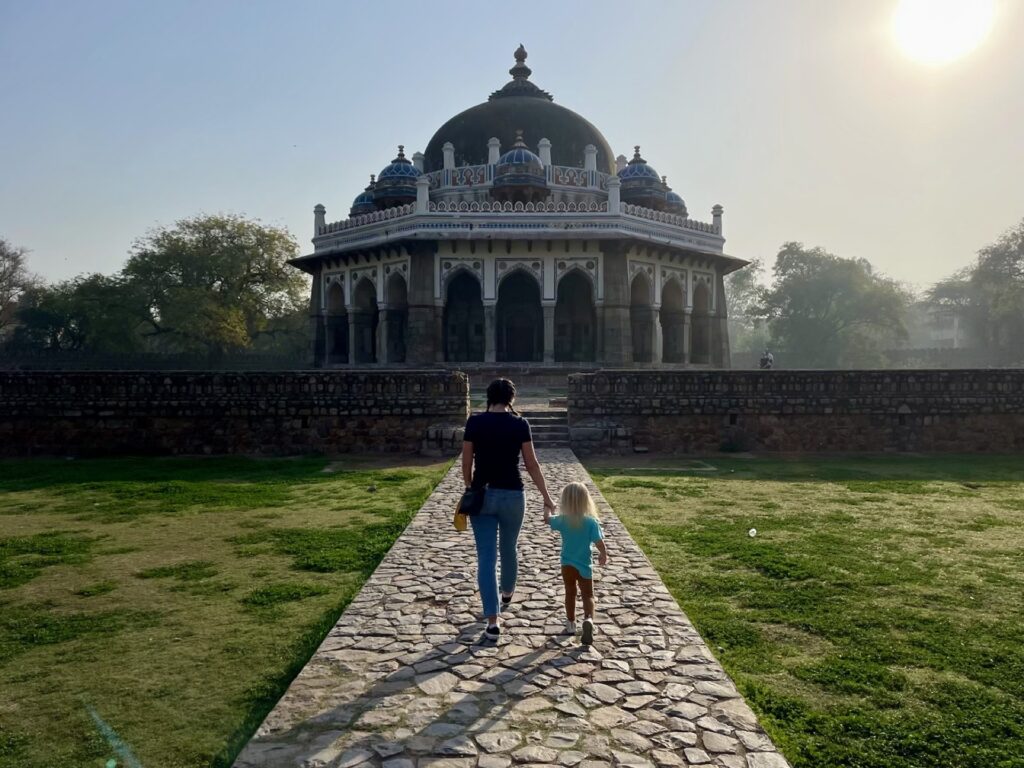
In this Post
- Golden Triangle Overview
- When to Go & How Long to Stay
- Visas & Vaccines
- Flights, Hotels & Transportation
- Golden Triangle Itinerary Overview
- Sample Itinerary: Delhi
- Sample Itinerary: Jaipur
- Sample Itinerary: Agra
- India Golden Triangle Tips
- Other India Guides
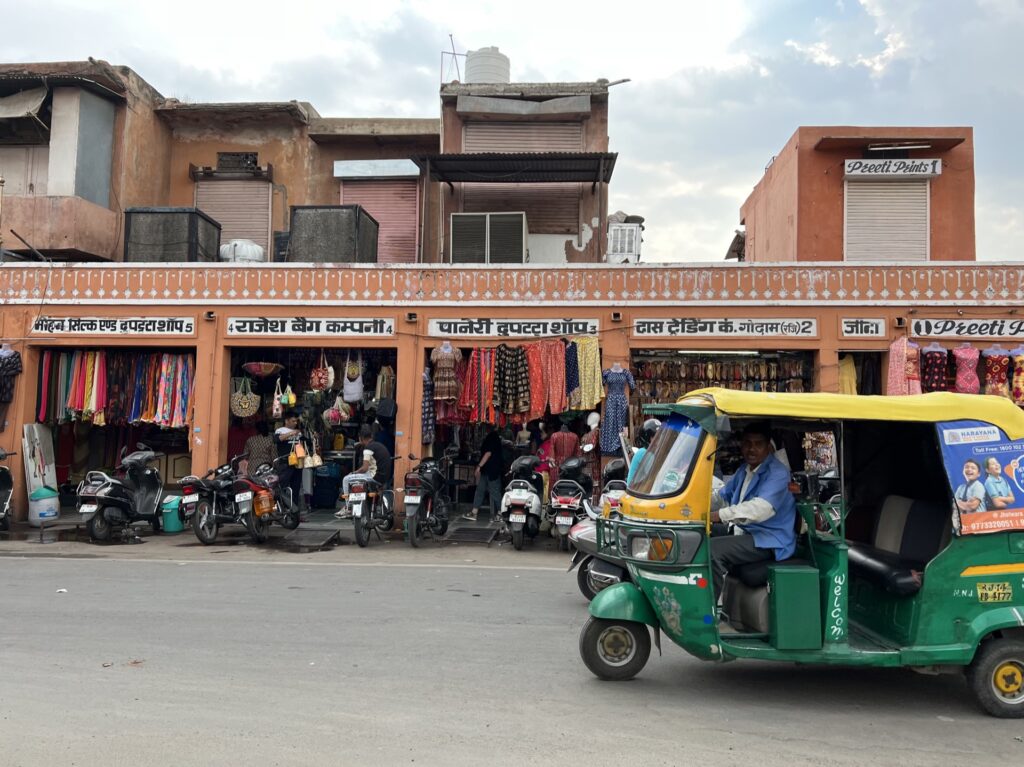
Golden Triangle Overview
If you’re going to India for the first time, the Golden Triangle is a great route to take. You’ll get to experience the chaos of Delhi, history of Jaipur and beauty of Agra in a single trip. The cities are relatively close together, and it’s a good way to sample Indian culture on a well-beaten tourist path.
The Golden Triangle starts in Delhi. Home to Indira Gandhi International Airport — the country’s busiest airport — most international travelers will start and end in Delhi. You’ll want to spend at least three days in Delhi, and it’s usually best to do that first. It’s a great way to get grounded and adjust to the culture.
From Delhi, you can do Agra or Jaipur in either order. We’d suggest Jaipur first and then finishing in Agra. Jaipur has a lot more to do, so you can ride the high-energy wave from Delhi right into Jaipur. Then you can wrap up in Agra, which is much more relaxing because there’s really just one main attraction. The Taj Mahal is a great reward at the end of 10 days in India.
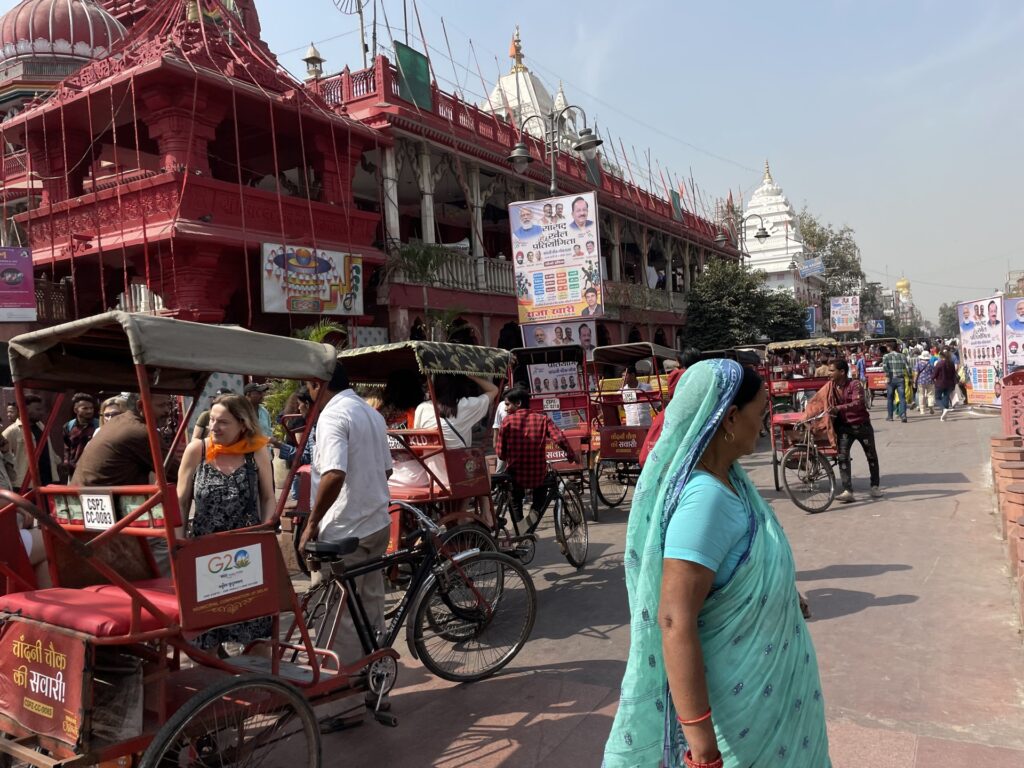
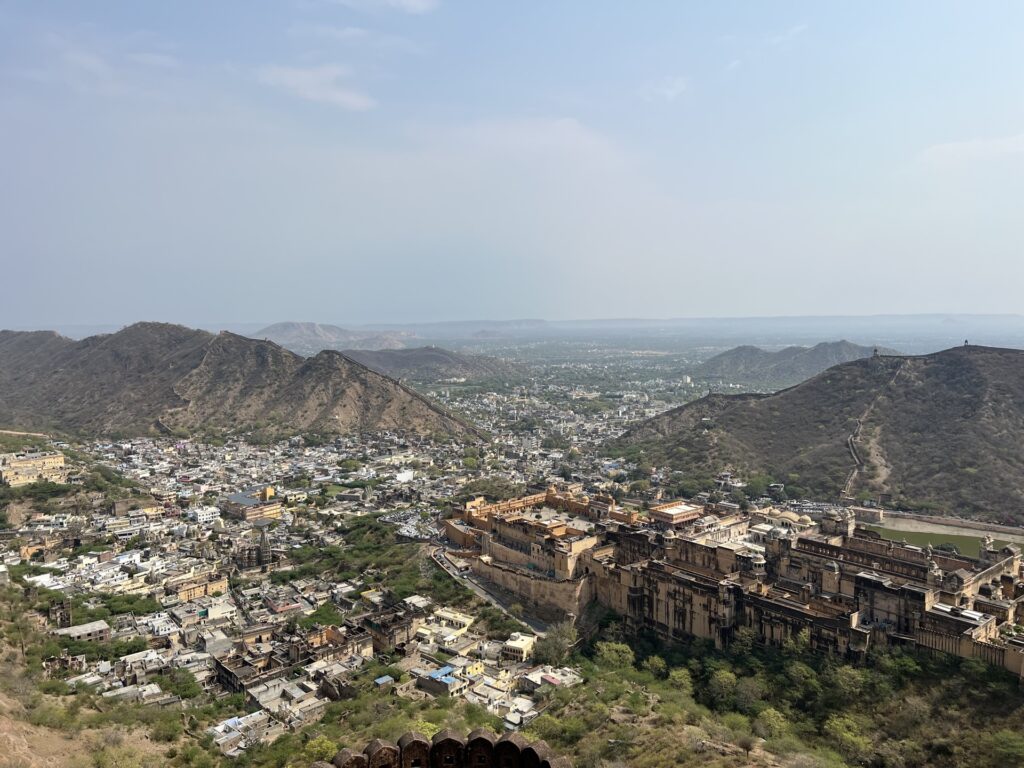

The three Golden Triangle cities are all roughly 200 miles apart from each other. You can move between the cities by train or you can hire a driver. We’ll discuss transportation in detail in a bit.
The Golden Triangle is a well-established tourist route. Nearly everyone in the tourism sector speaks English, you’ll have your pick of hotels, and there will be a wide array of foods available. Yes, you can find authentic Thali and dal everywhere you go, but you can also find pizza and burgers just as easily.
Overall, the Golden Triangle is an ideal route for first time travelers because it packs a huge punch with (relatively) little effort. The taste of India you get on the Golden Triangle will make you realize just how big and diverse India really is. And if you’re anything like me, you’ll be planning a trip back before you even leave.
Best Time to Visit the Golden Triangle
The three cities on the Golden Triangle are all pretty close together, and they share similar weather patterns. The climate in this region of India can be intense, so it’s really important that you plan your trip at the right time.
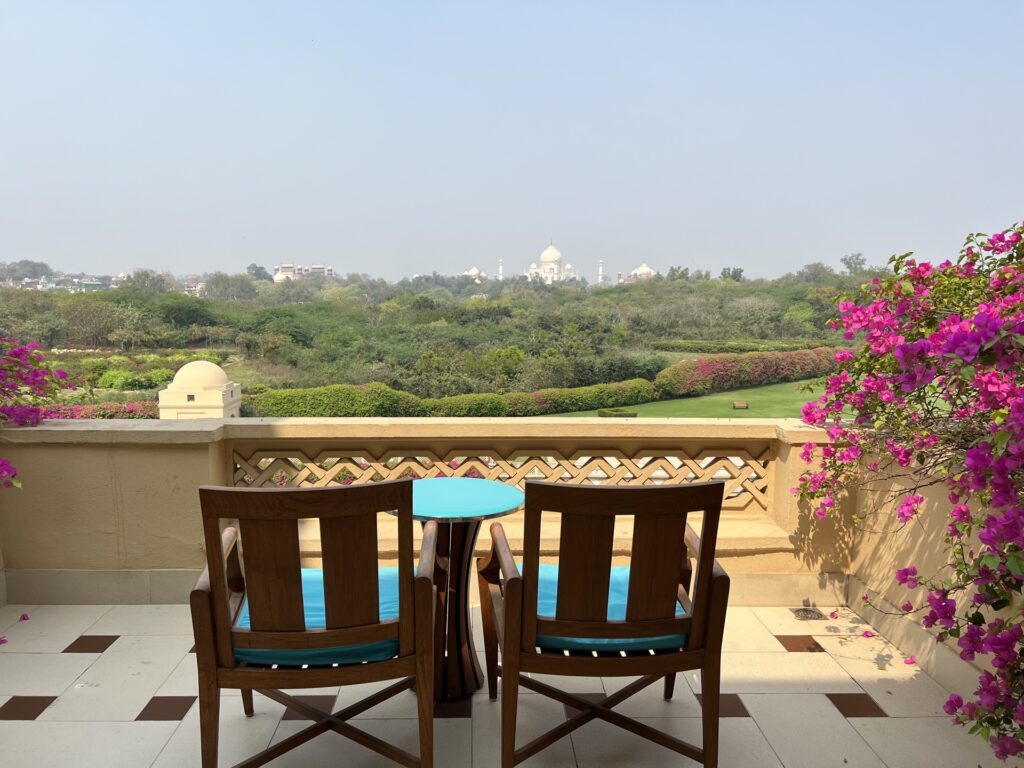
Here’s a look at the weather in this region by season. All temperatures are in °F.
- Golden Triangle in the Summer (April – June): Summer is extremely hot with temperatures regularly hitting 100°F or higher.
- Golden Triangle Monsoon Season (July – September): The monsoon season means frequent heavy rains and intense humidity. Temperatures typically stay in the 90s. Avoid monsoon season at all costs.
- Golden Triangle in the Fall (October – November): The rainy season gives way to a milder fall. High temps are still in the 80s, but the lows start to dip to the 50s and 60s.
- Golden Triangle in the Winter (December – January): Winter is very comfortable for travelers who are coming from more temperate climates. The lows can be really cold — as low as the 40s — but the highs tend to hover around the low 70s.
- Golden Triangle in the Spring (February – March): Temperatures shoot up quickly in the spring and can vary greatly by the day. Highs will hit the 70s and 80s and lows will move up to the 50s and 60s.
The best time to visit the Golden Triangle is in the late winter or early spring (January through March). You definitely want to avoid the summer’s crippling heat and monsoon season, which can easily damper any holiday.
For any chart people like me, here’s the table I put together to inform the summary above. (Weather data source: Weather Spark)
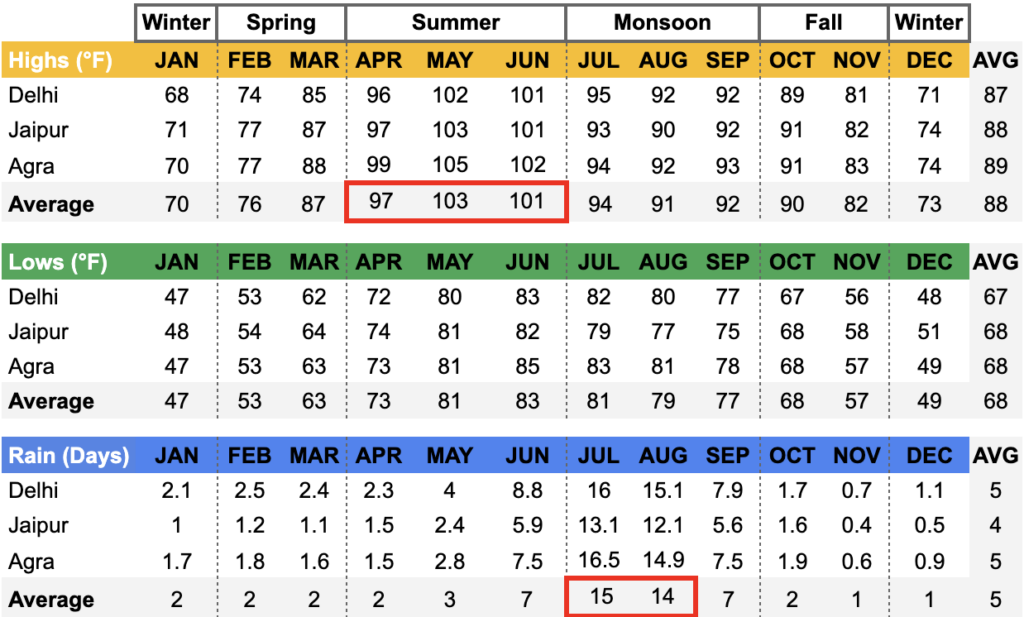
How Long Do You Need for the Golden Triangle in India
Generally speaking, we recommend spending 10 days on the Golden Triangle. This is a pretty relaxed schedule, so you should have enough time to see most of each city’s best attractions and have time to relax in the afternoons and evenings. Ten days will also allow you to dedicate full days to travel between cities. This is ideal because then you don’t have to rush or worry about missing anything in the case of travel delays.
If you don’t have a full 10 days, you could fit the Golden Triangle into as few as 7 days. This is tighter, but it would work for someone who has the energy to pack their days full. (Pre-kid us would have definitely tackled it in 7 days.) If you’re doing a shorter trip, I’d recommend a car service between cities so you have more control over your travel time and schedule.
If you have more than 10 days in India, I’d recommend adding another city instead of dragging out the Golden Triangle. One great city to the add to the Golden Triangle is Udaipur. It’s a bit of a hike, but you can get there by car or train. It’s a beautiful and city to spend 3-4 days in addition to the Golden Triangle.
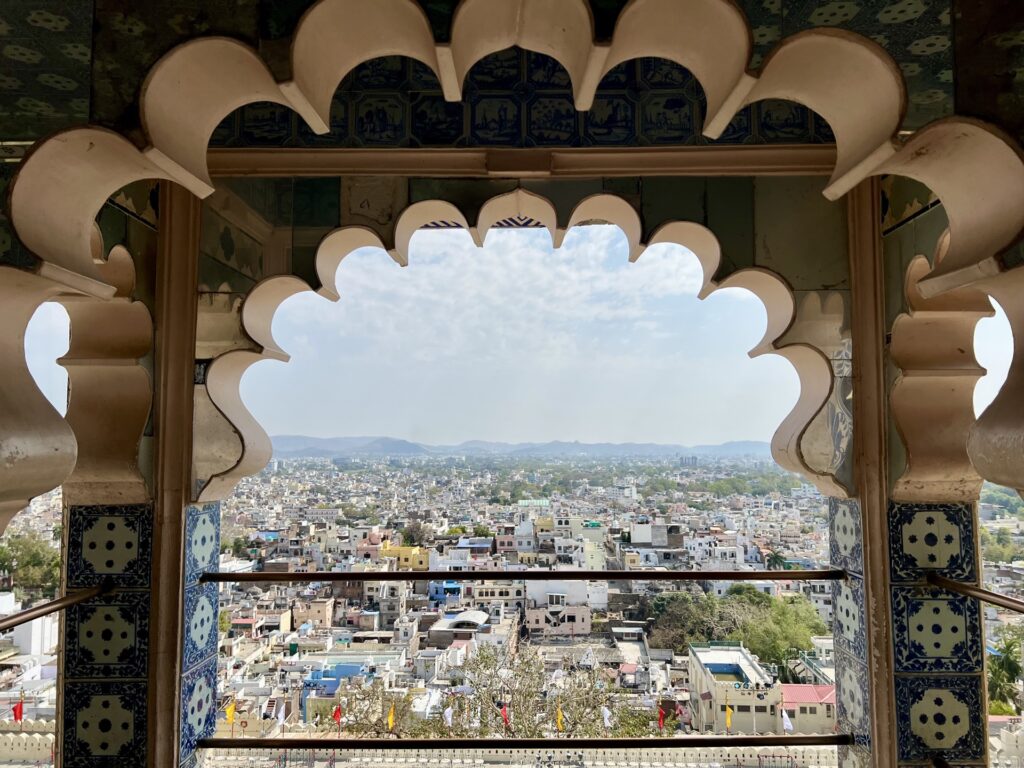
India Visa Requirements
To visit India, you need to secure a Tourist e-Visa before your trip. The Tourist e-Visa is required for visitors from almost every country and has three available durations: 30 days, 1 year, 5 years.
You can apply for an Indian Tourist e-Visa online. You will need a valid passport, passport photo, and credit card to pay the application fee. The application fee varies based on your nationality.
In most cases, this is a quick and easy process, but don’t put it off till the last minute. It can take longer if complications come up. My husband and I submitted separate forms. Mine came back in 24 hours, but his took a few weeks. (We’ve both been to the same countries.) Eventually we were both approved, but it’s just a good idea to get it as soon as possible.
Recommended Vaccines for India
India does not mandate any vaccines for visitors from most countries. (The only exception to that is the Yellow Fever vaccine, which is required if you’re traveling from a high-risk Yellow Fever country.) However, you might still want to get a few vaccines before you travel to India.
In the United States, the Centers for Disease Control and Prevention (CDC) recommends the following vaccines for travelers going to India. Other countries may have different guidelines.
- COVID-19
- Hepatitis A
- Hepatits B
- Measles
- Yellow Fever
- Rabies
- Typhoid
- Cholera (not prevalent in the Golden Triangle)
- Malaria (not prevalent in the Golden Triangle)
- Japanese Encephalitis (not prevalent in the Golden Triangle)
We were already up to date with most of these vaccines including: Covid, Hep A, Hep B and measles. We also already received Yellow Fever vaccines before traveling to Colombia a few years ago. Based on our travel plans (Delhi, Jaipur, Udaipur, Agra), we weren’t at high risk for cholera, malaria or Japanese Encephalitis. That left us with Rabies and Typhoid to consider.
If it was just us adults, we probably would have skipped both. Since we were traveling with a 2-year old, we booked a travel consultation with our pediatrician. Our child was fully caught up on their required vaccines, and the doctor actually didn’t strongly recommend any additional vaccines.
We decided to skip the rabies vaccine. Stray dogs are definitely a thing in the Golden Triangle cities (they are just about everywhere in India), but we assumed we would be able to stay pretty clear of them. Meanwhile, Typhoid spreads through contaminated water, and that seemed like a risk that would be harder to avoid completely. We decided to get the Typhoid vaccine for all of us.
The Typhoid vaccine is expensive. It costs around $150 and most insurance doesn’t cover it. (Our insurance covered children but not adults.) It’s also really hard to find. In many cases you have to go to a travel clinic to get it, which can sometimes cost another few hundred dollars. We live in NYC and were fortunate that our pediatrician and local CVS had it in stock.
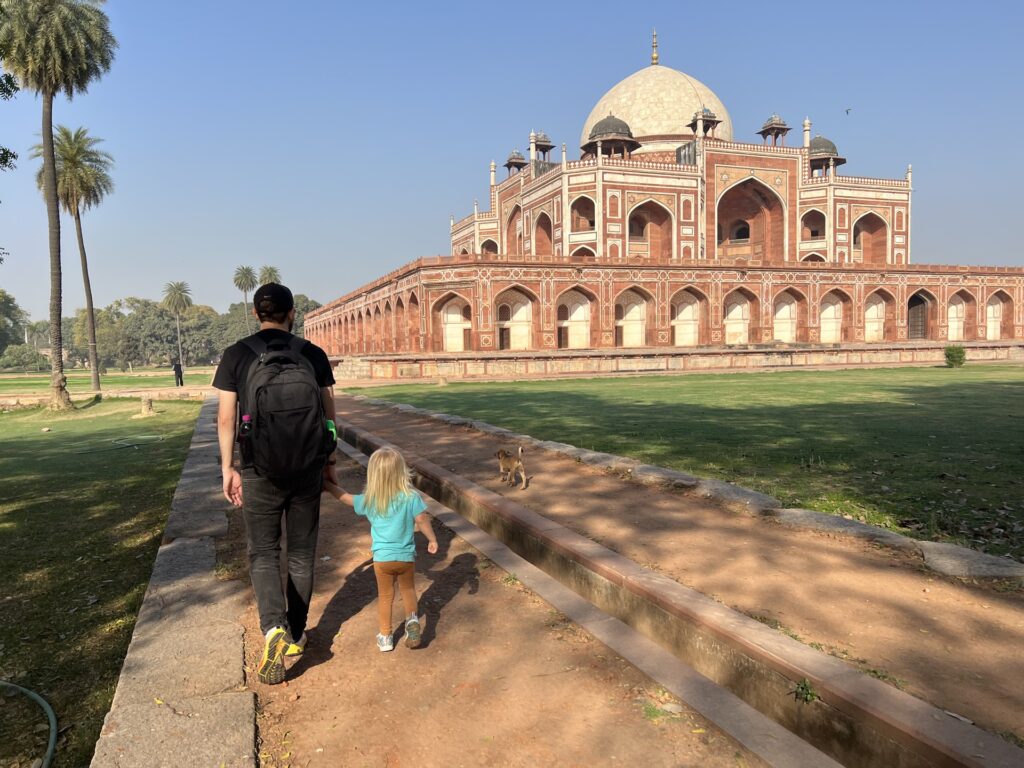
(Disclaimer: We are not doctors and this is not medical advice. Consult your physician or a travel clinic for professional recommendations.)
Flying to Delhi
The journey around the Golden Triangle usually starts and ends at Indira Gandhi International Airport (DEL) in Delhi.
Air India is the flag carrier airline of India. While Air India isn’t known for being one of the better airlines, we personally had a pleasant experience flying Air India Business Class from Dubai to Delhi. I wouldn’t recommend flying Air India long-haul, but it’s a fine option if you’re traveling regionally.
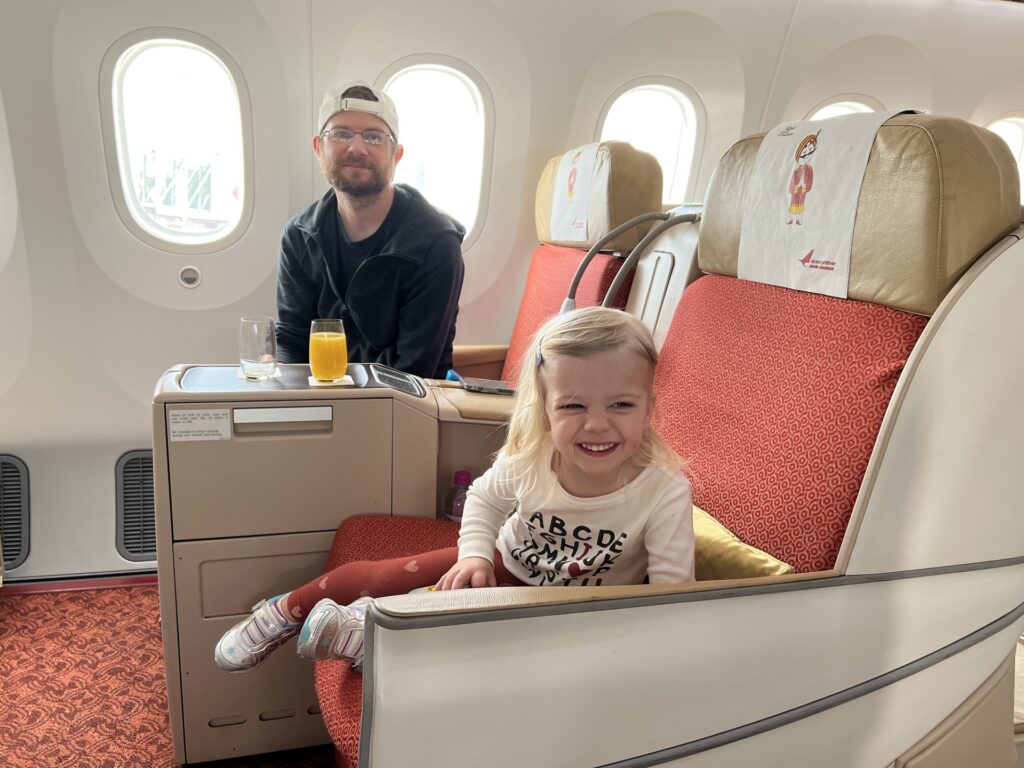
Plenty of other international carriers fly to Delhi, so you’re probably better off flying your home country’s flag carrier instead.
There is a Metro stop at the airport, and the Delhi Metro is incredibly nice and clean. The Metro is a great way to get into the city if your hotel is near a Metro station (such as one of the many hotels near Connaught Place.) The Metro is also a great way to get from the airport to the train station, which is good if you’re planning to head right out to Agra or Jaipur and see more of Delhi on the tail end of your trip.

If you’re staying in Delhi for a few days and your hotel is not near a train station, your best bet is to take a car. Taxis are available at the airport and offer pre-paid or metered fares. The airport website recommends pre-paid fares, which requires going to the taxi counter to get a ticket first. Uber is also available in Delhi, so that’s a better option as long as you have cell service or wifi (there is free wifi at the airport).
If you are willing to spend a bit more, the easiest option is to book a car service. We booked a car service through our hotel and it was incredibly smooth. They were waiting for us with a sign when we cleared customs and they got us right to our hotel without any hassle. If you’re arriving in India after a long-haul flight, you will want the comfort and ease of a car service.
Choosing Hotels on the Golden Triangle
The three cities on the Golden Triangle are all populous cities and tourist hubs. There is a variety of hotels and accommodations available at a wide range of price points.
You can do the Golden Triangle (and honestly all of India) one of two ways.
One option is to take the budget route. You can find decent hotels and guesthouses on the Golden Triangle route for pretty cheap. Many of these accommodations receive glowing reviews. For example, Treebo Trend The Armani hotel in Delhi typically goes for less than $100 USD per night and is rated 4.8/5 on Google and 7.3/10 on Booking.com. And for India, that’s pretty pricy. You can find stays as low as $20-$30 a night if you’re willing to be adventurous.
Another option is to go the luxury route. India has some of the best hotel chains in the world. Specially, Oberoi Hotels & Resorts and Taj Hotels consistently rank on the World’s Best Hotel Brands list by Travel + Leisure. These deluxe hotels provide accommodations that are in stark contrast to the conditions you’ll see around most of these cities. A single night at one of these deluxe hotels can set you back over $1,000 USD.
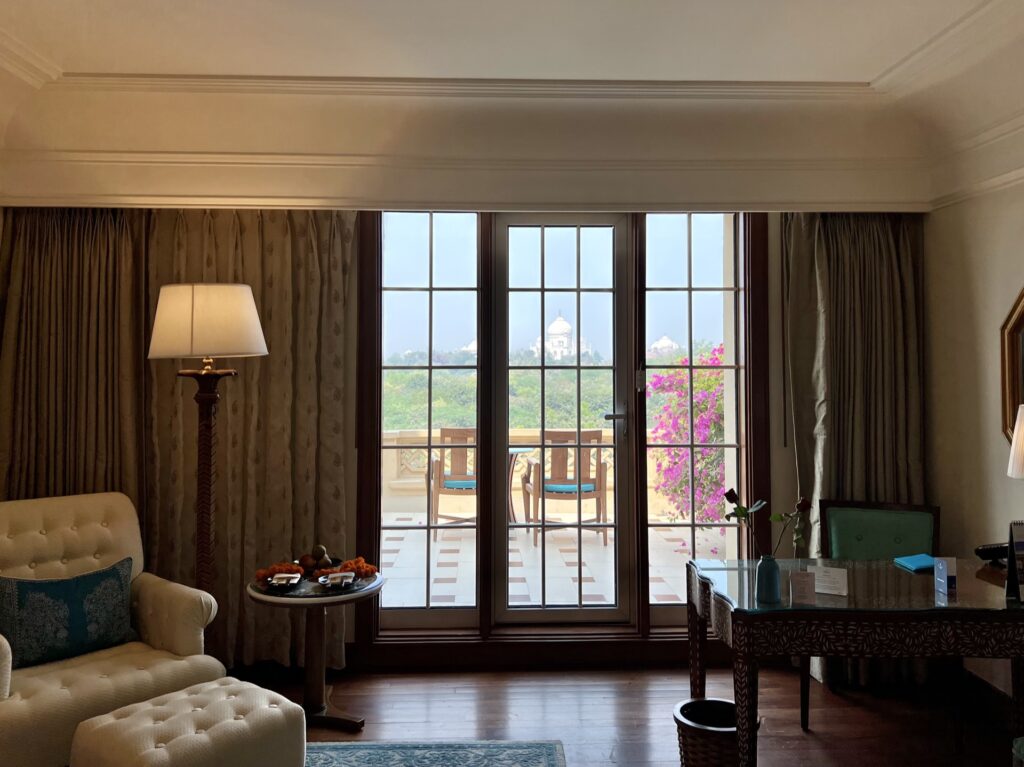
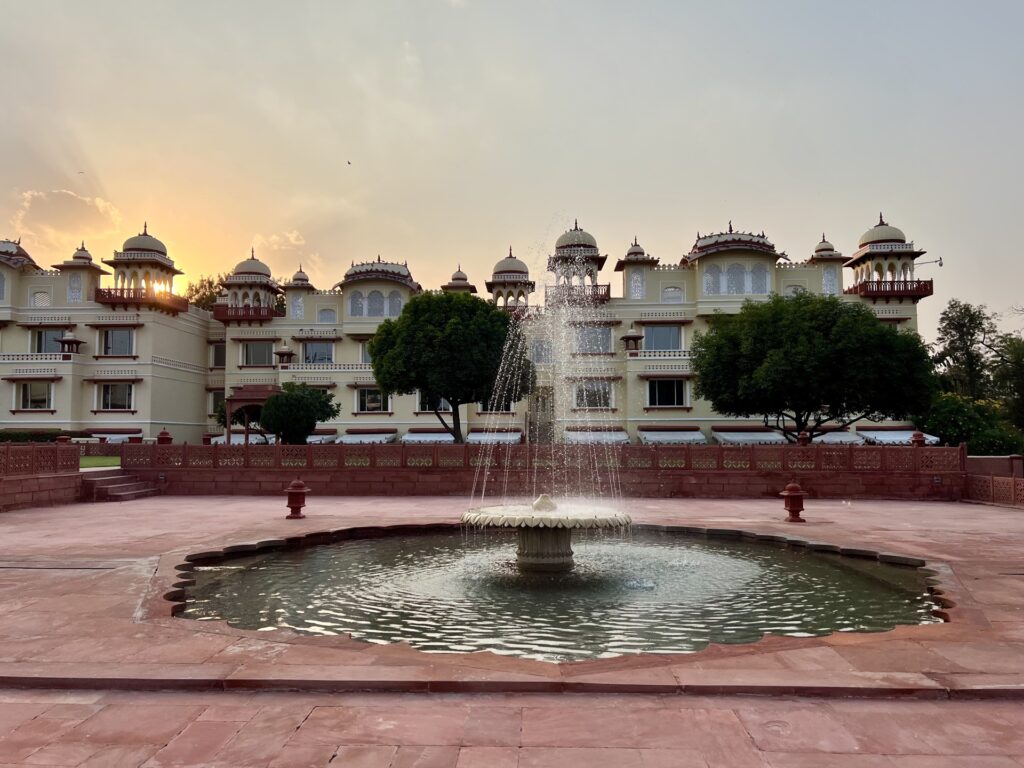

Sure, there is a middle ground between these two extremes, but I would argue that it’s not really worth it. You can find good, clean, safe accommodations in the $100 range and the up charge to the $200-$300 dollar range don’t really offer substantial improvements relative to the price increase.
If you can afford to splurge on a nicer stay — even if it means delaying your trip for an extra year to save up — I would highly recommend it for the Golden Triangle. This isn’t something I say lightly or would say for many other destinations, but I feel strongly about it in India.
As much as I loved the Golden Triangle and India as a whole, it is physically and emotionally exhausting. A nice hotel can serve as an oasis, allowing you to recharge between excursions. This reset will prevent you from burning out too quickly and keep you open to experiencing the cities in shorter bursts.
I would never recommend going into debt or living outside your means. I am confident you can create this oasis at a hotel in the $100 price range. That said, if you have the budget and this is a once-in-a-lifetime trip for you, the luxury hotel options are incredible.
Personally, we went the luxury hotel route. You can check out detailed reviews for each hotel we stayed at on the Golden Triangle by visiting the link section at the end of this post.
- Delhi: The Oberoi New Delhi and JW Marriott New Delhi Aerocity
- Jaipur: Jai Mahal Palace
- Agra: The Oberoi Amarvilas
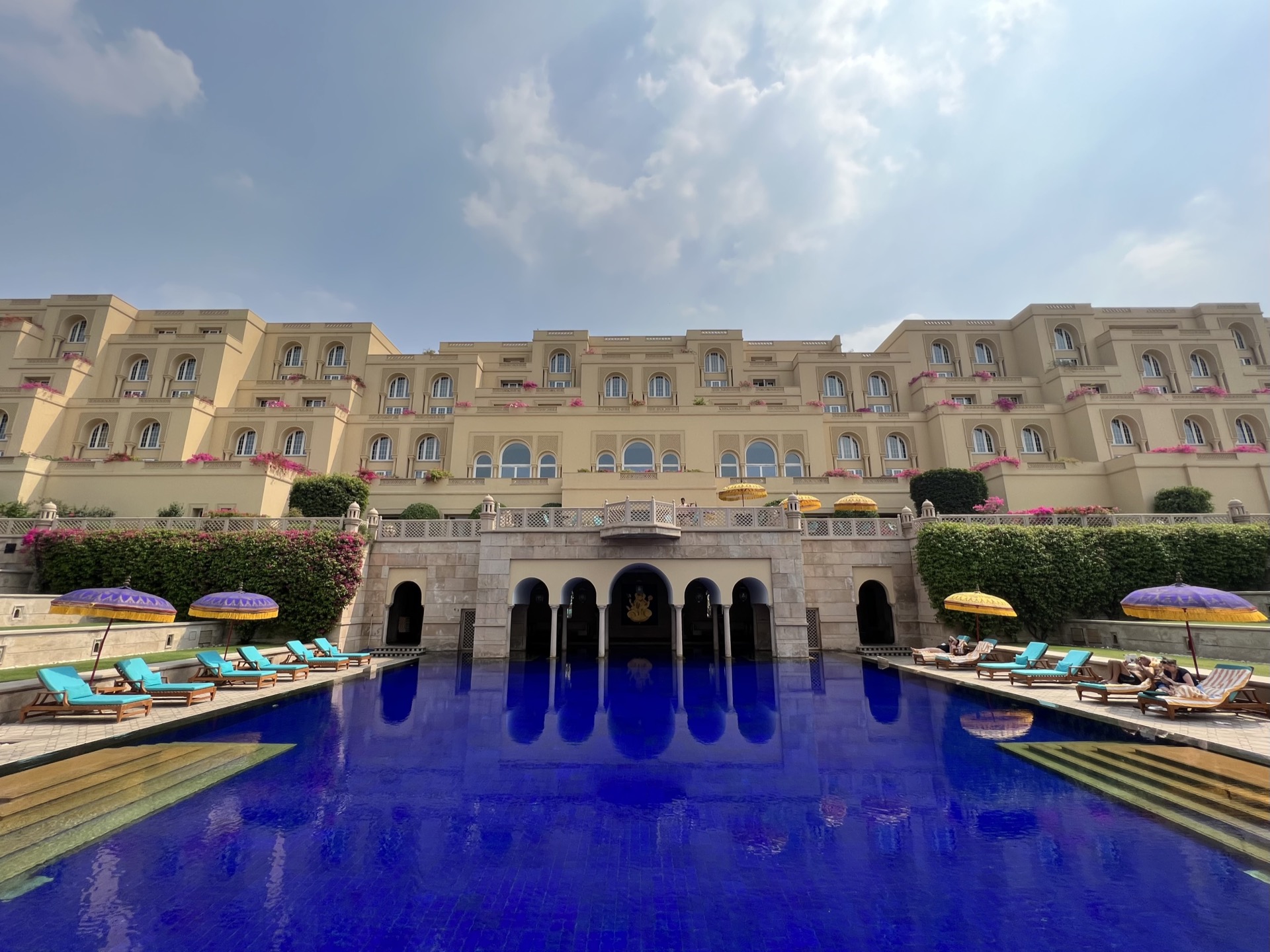
Getting Around the Golden Triangle
There are two main options for getting between the cities on the Golden Triangle.
The cheapest option is to take the train. Indian Railways runs an impressive network of routes all over the country, including the Golden Triangle. Trains in India are definitely an experience, but they’re not all the jam-packed trains you might have seen on social media. At least not for tourists. We took several trains in India and generally had very positive experiences.
Tourists should book the highest travel class available (which is still cheap by global standards), which includes assigned seats and AC. The train stations can be a bit hectic, but they have very clear signage (in English and Hindi) and the trains usually run on time. In our experience, the trains were always very clean and the experience from start to finish was pretty organized.
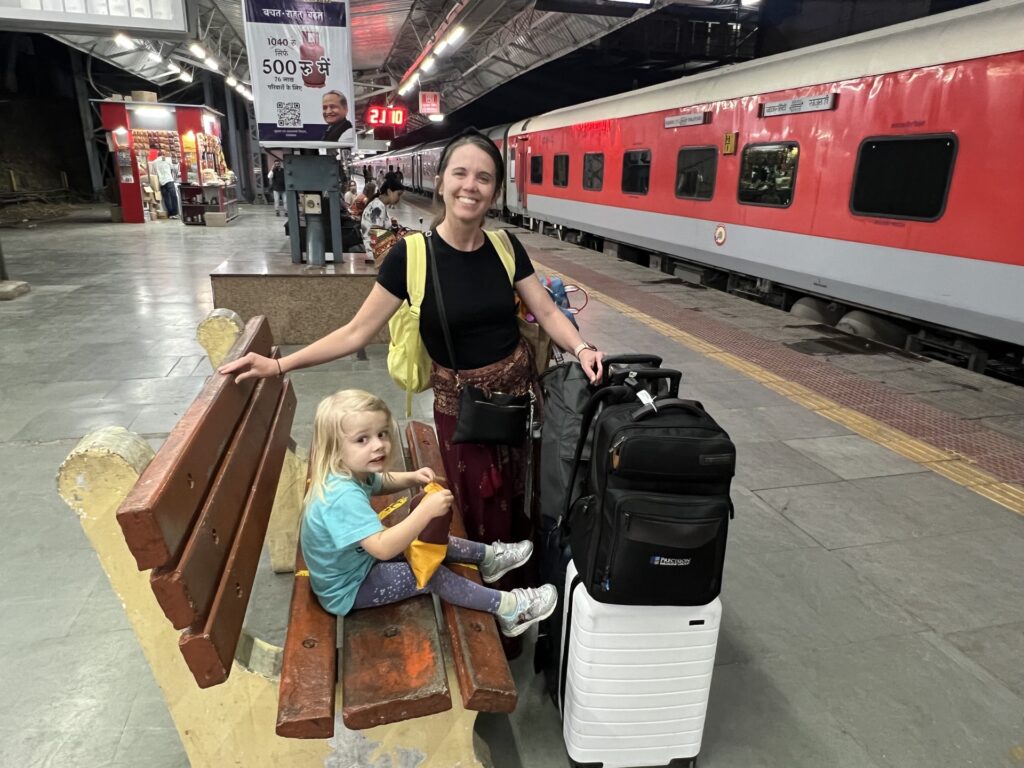
You can book Indian Railways train tickets online in advance. For international travelers, the easiest way to book Indian Railway tickets is through a third-party service 12GoAsia. (It’s very difficult to buy direct from Indian Railways from outside of India.) We’ve used 12GoAsia all over Asia and most recently during our trip to India. We have always had a great experience, particularly with their customer service. (This is not sponsored, we’re just fans of their service.)
Rail travel is not without it downsides. You’ll have to carry your bags around (often up and down stairs), navigate the station to find your train and car, and figure out transportation between the station and your hotel. On top of that, you will have less control over your schedule. Some routes are not at the best times, and there’s always the chance that your train is delayed.
To avoid all of that, the easiest way to get between Golden Triangle cities in India is take a car. The obvious advantage to a car service is that you will have door-to-door service between hotels, which means you don’t have to deal with any other transportation or lugging your bags. It also gives you more control over your schedule. Traffic can always be an issue, but you can start your journey pretty much whenever you want.
Most hotels in India have a car service they recommend and can book that for you. Their service will usually be more expensive than finding someone on your own. We booked through Bagga India Tour for one leg of the Golden Triangle (Delhi to Jaipur) and it worked out great. You can also save a bit of money by booking one car service for the entire journey, instead of booking each leg separately.
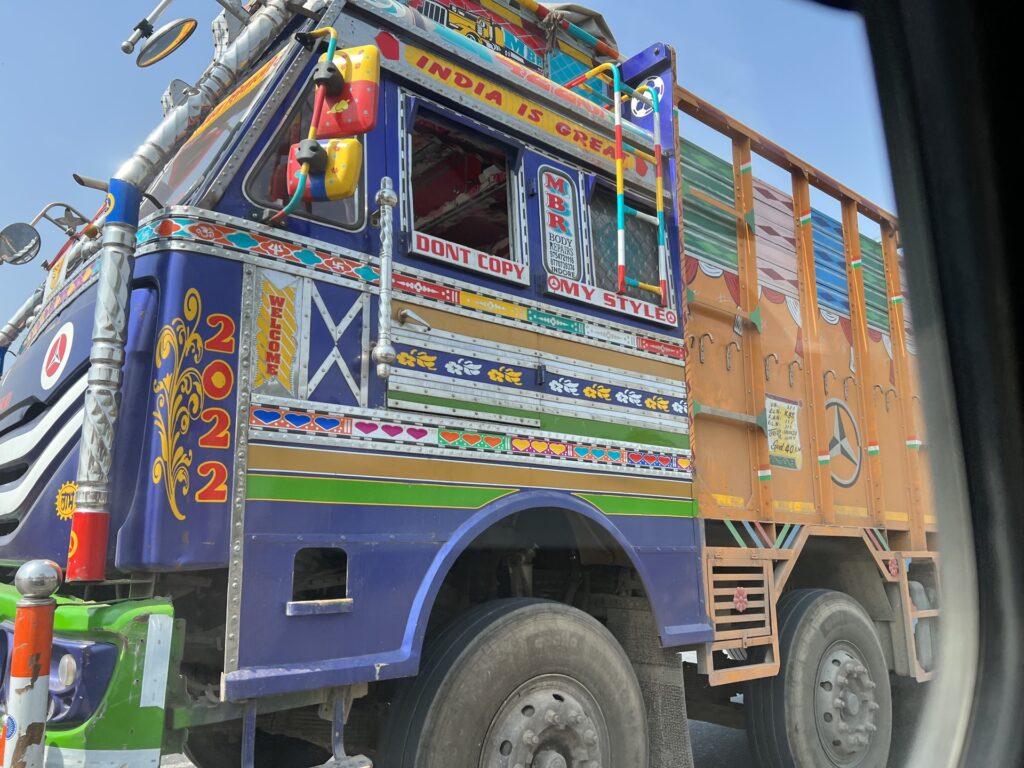
Finally, you can potentially fly between some legs of the Golden Triangle. (There is no flight between Agra and Delhi.) Don’t let the short flight times and cheap prices fool you, though. The airports in these cities are far from the city centers, and the airports are often very crowded and slow. By the time you factor in the transit, security waits and the flight itself, you’re not actually saving much time or money.
10-Day India Golden Triangle Itinerary
In these next sections, we’ll go into the details of our 10-day trip around the golden triangle. This itinerary largely mirrors the route we personally took. We added a few days in Udaipur between Jaipur and Agra, but this is how we handled the Golden Triangle portion.
Here is an overview of the itinerary we’ll cover in this post.
- Day 1: Arrival in Delhi
- Day 2: Delhi — Old Delhi
- Day 3: Delhi — Old Meets New
- Day 4: Delhi — Tombs & Gardens
- Day 5: Travel from Delhi to Jaipur
- Day 6: Jaipur — Forts & Palaces
- Day 7: Jaipur — Jaipur Old City
- Day 8: Travel from Jaipur to Agra
- Day 9: Agra — Taj Mahal
- Day 10: Return to Delhi and Departure
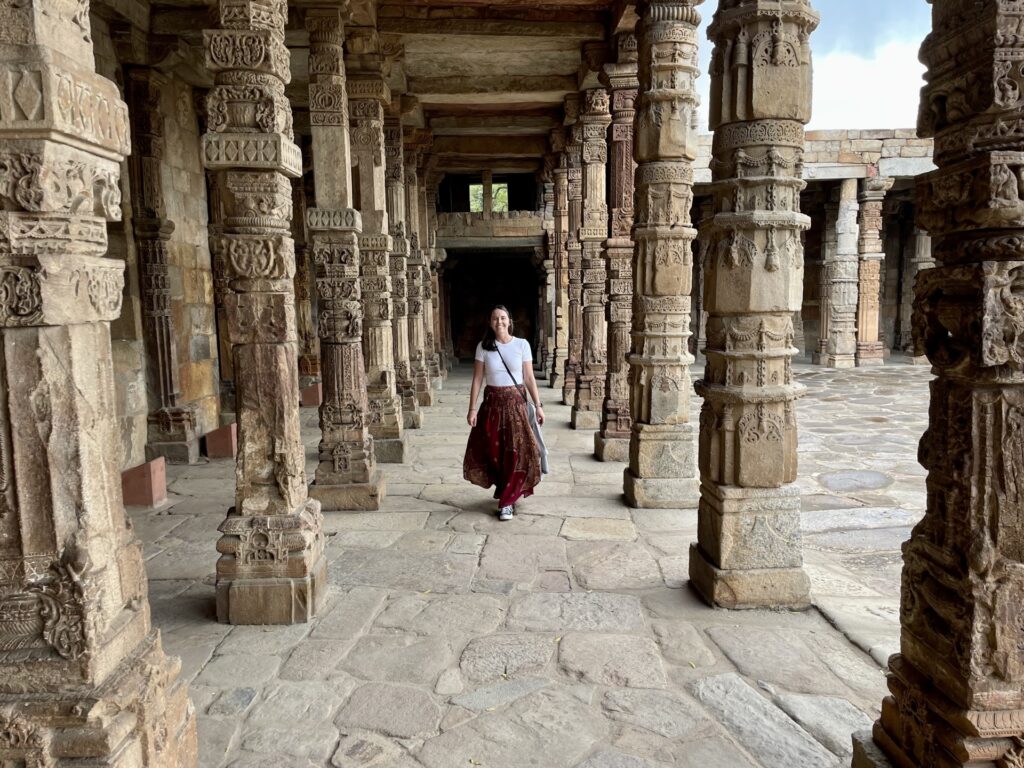
There are plenty of ways you can slice 10 days on the Golden Triangle. We think the itinerary above offers the best balance based on things to do in each location. However, there are two easy alterations you could make to this schedule that would still make sense.
The first change I’d consider is to cut the second day in Jaipur. If you squeeze all of Jaipur into one day on Day 6, you can travel to Agra on Day 7, see the Taj Mahal on Day 8, and then use Day 9 to return to Delhi. This change gets you back to Delhi a day sooner so that you can easily make a morning flight out of Delhi.
Another change you could consider is skipping the overnight stay in Agra all together. You can take a day trip to the Taj Mahal from Delhi, and that often winds up being cheaper and easier than staying in Agra. You could return to Delhi on Day 8 and then do a day trip to Agra on Day 9. Alternatively, you could also add an extra day in Delhi on the front end and do the day trip then. Then you can come back from Jaipur on Day 9 and go straight to an airport hotel for the night before you fly out.
Without any further ado, let’s dive into the itinerary.
Day 1: Arrival into Delhi
We were traveling to India from the US. A direct flight from NYC to Delhi takes 14 hours and includes a 9.5-hour time change. (Yes, you read that right, they are 30 minutes off from GMT.) We decided to break that up with a pitstop in Dubai first.
We decided to fly Emirates Business Class from New York to Dubai. Then we spent a few days in Dubai staying at Atlantis. If you have some extra time in your schedule, I’d highly recommend something like this. It’s a great way to slowly adjust to the time change so you’re fresh and ready by the time you get to Delhi.
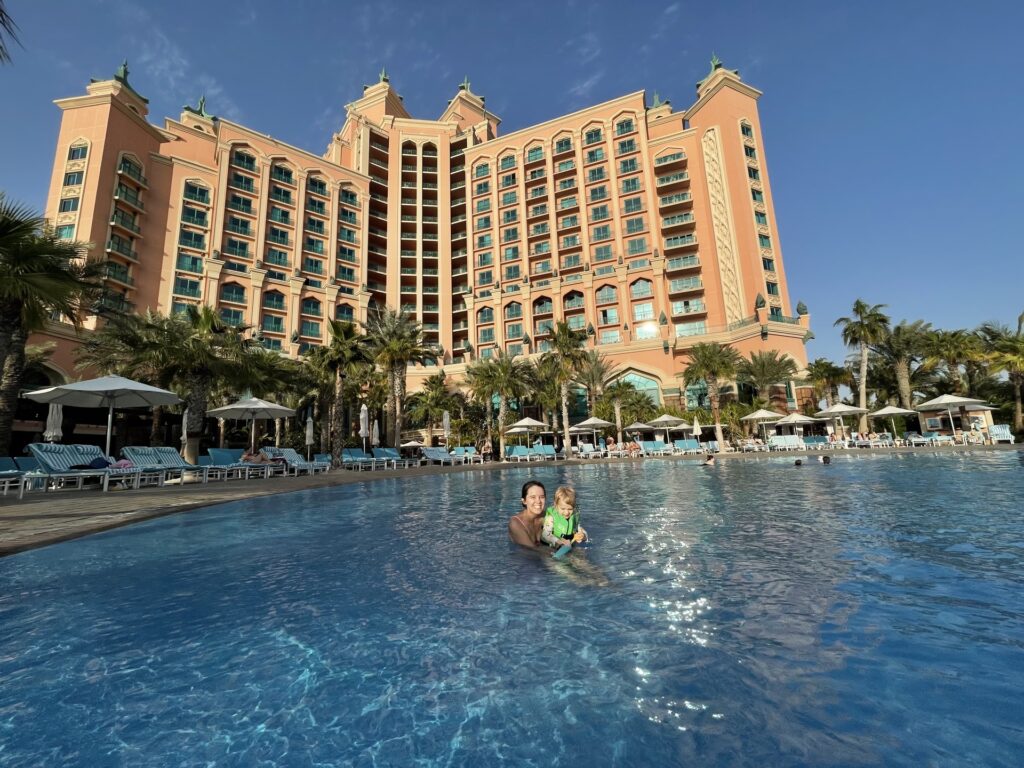
Our flight from Dubai arrived in Delhi at 2:45 PM local Delhi time. The lines for border patrol were brutal, even the expedited lanes for families and premium class travelers. We waited for over an hour. This is yet another reason we were glad that we had the Dubai stopover. Waiting in that line after a 14 hour flight with a toddler when everyone was exhausted would have been much less pleasant.
It’s also just a great example of why you don’t want to have any concrete plans on your arrival day. Even if your flight is on time, you can still get delayed in ways out of your control.
After we cleared customs, everything was smooth sailing. We had arranged a car service through our hotel and they were waiting for us as soon as we exited customs. They carried our bags to a nearby SUV, which had the AC blasting and was stocked with bottled water.
According to Goole Maps, the drive should take about 20 minutes. In reality, it took closer to 45, and it was eventful. Lanes and traffic lights were seemingly optional, our SUV looked massive amid the swarm of tuk tuks and motorbikes, and we even spotted our first holy cows.
We soon arrived at our hotel, The Oberoi New Delhi, which felt like a world away. After a warm welcome, we got settled into our room and enjoyed dinner at one of the hotel restaurants. Even after a short flight, we were ready to pass out and rest up for our first day in Delhi tomorrow.
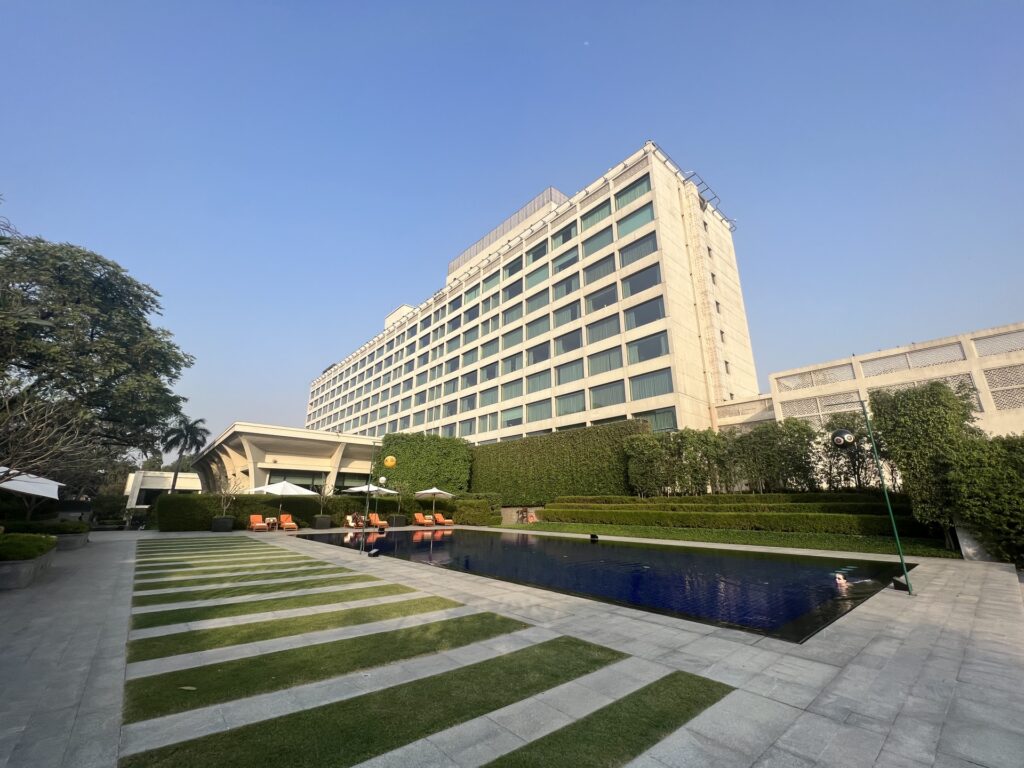
Day 2: Delhi — Old Delhi
Note: For detailed information about every attraction we saw in Delhi plus even more things to add to your itinerary, check out our sample itinerary for 3 Days in Delhi.
We started our day with room service breakfast. While there are plenty of restaurants in the Old Delhi area, our personal preference on this trip was to primarily only eat at our hotel. Though certainly an extreme approach, this was our best strategy for avoiding the dreaded “Delhi Belly” for ourselves and our little one. (It was maybe overkill and at times boring, but it worked.)
The Oberoi New Delhi is not close to the Metro, so we needed a car to get to Old Delhi. If we were just traveling as adults, Uber would be an ideal transit option. However, we were traveling with a toddler who needed a car seat, so that didn’t work for us. Instead, we booked a car and driver for four hours through the hotel (starting at 8 AM).
We needed the car to get from the hotel to Old Delhi. But after our first stop (Jama Masjid), our driver handed us off to a rickshaw driver. We relied on the rickshaw driver to get us around the pedestrian streets and narrow alleys in Old Delhi that are not accessible by car.
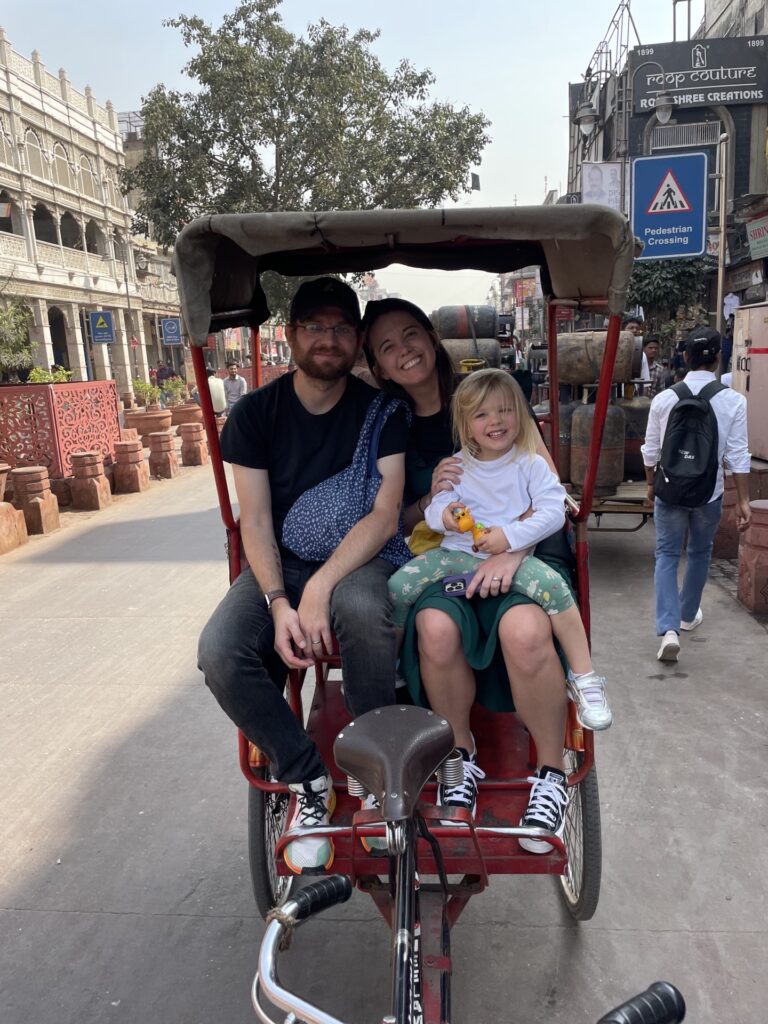
The rickshaw driver took us on the following route, most of which we requested:
- Jama Masjid (Mosque)
- Red Fort (Former royal residence with old palaces, small museums and gardens.)
- Chandni Chowk (Iconic street market where you can find food, clothes, housewares and just about anything you could think of for very cheap.)
- Small street of Jain houses (There is a very instagrammable house here in an enclave just off the market. Be prepared to tip the owner or shop in his store.)
- Tea Shop (There will always be a friend’s shop that sells the best tea in town on any tour you take. We got suckered into this one.)
We had a great time visiting each of these sites. Everything I read about Old Delhi made it sound like an extremely chaotic culture shock, but we didn’t feel that. The neighborhood has a rhythm, a heartbeat, and it just sweeps you up. It’s beautiful and loud, but in an almost hypnotic sense. We only skimmed the surface of this neighborhood, but what we did experience we loved.
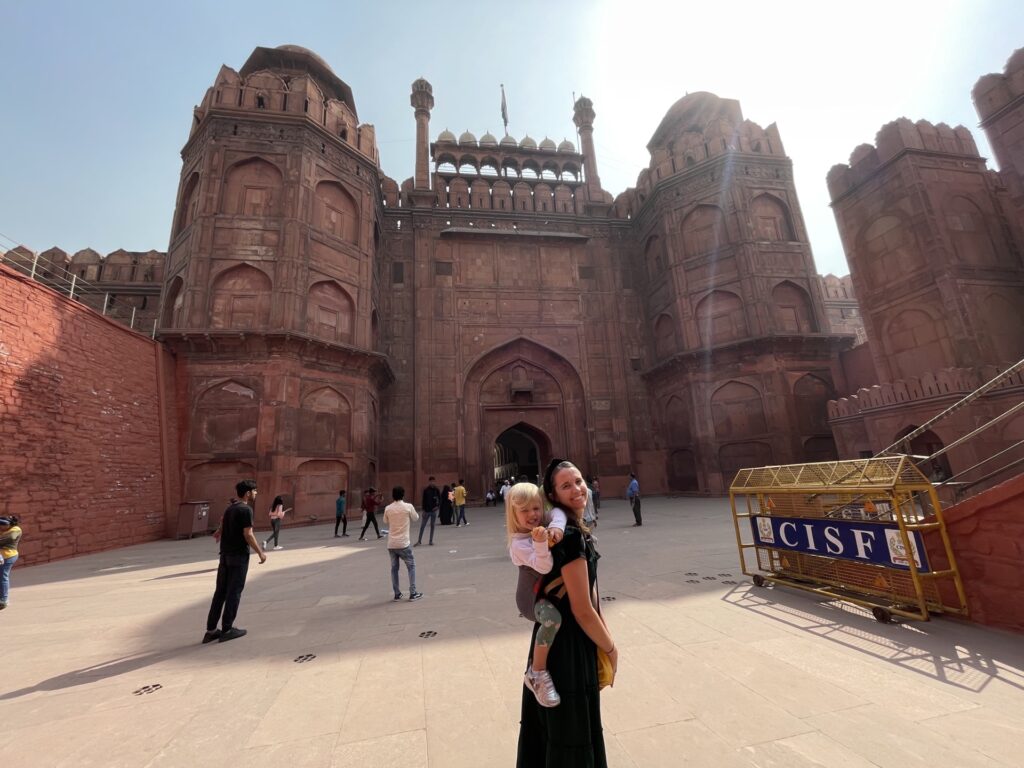
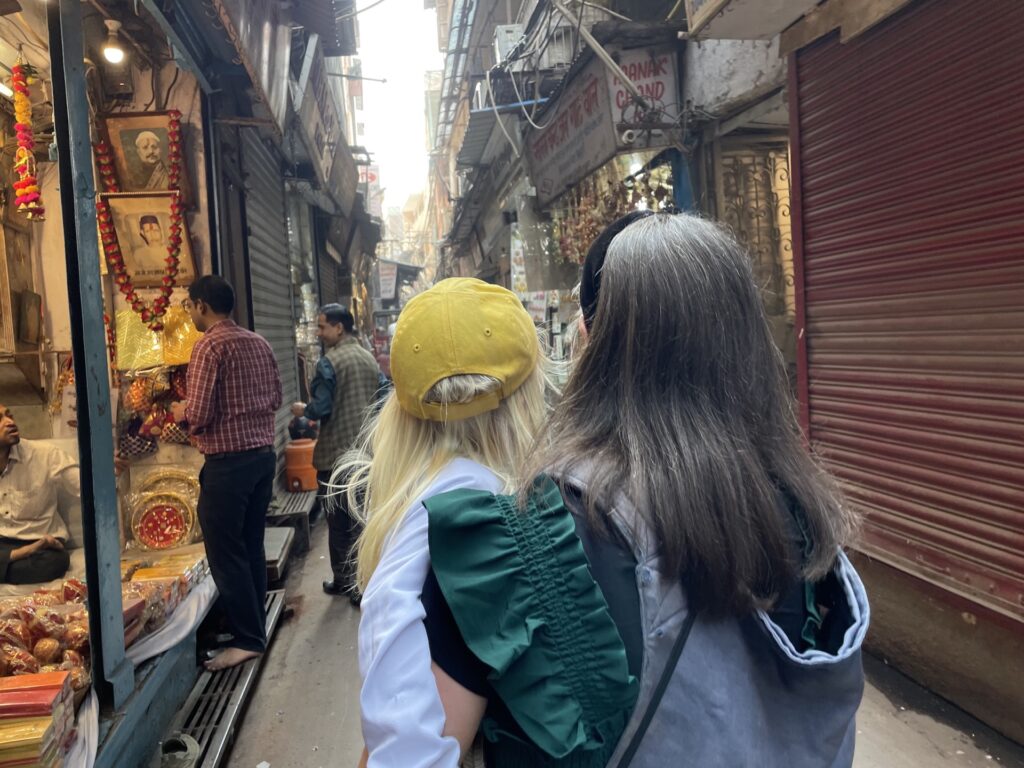
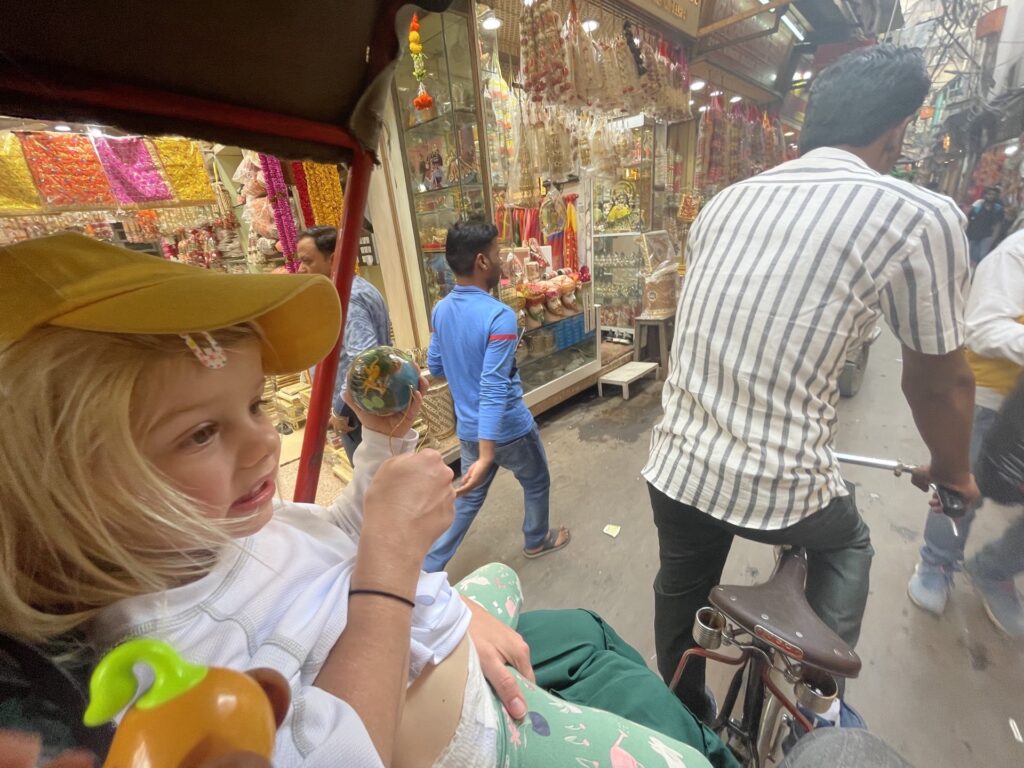
After about 3 hours, we returned to Jama Masjid where we met our driver. Neither our driver nor the rickshaw guide would tell us exactly what we owed for the tour. They insisted it was tip as much as we wish, but we tipped 3x as much as the tour price (which was quoted to us as Rs 400, $5 USD) and he still seemed disappointed.
We returned to our hotel, ate lunch at the hotel restaurant and then put our toddler down for a nap. During that time, Kenny went for a run in the hotel gym and then I got a coffee and macaron in the hotel patisserie.
After the nap, we spent the rest of the afternoon relaxing at the hotel. And by relaxing, I mean we spent two hours in the pool which was pretty cold in February. We wrapped up our first full day in India with Indian food in India! (Yes, it was just from the hotel restaurant but it was still really good!)
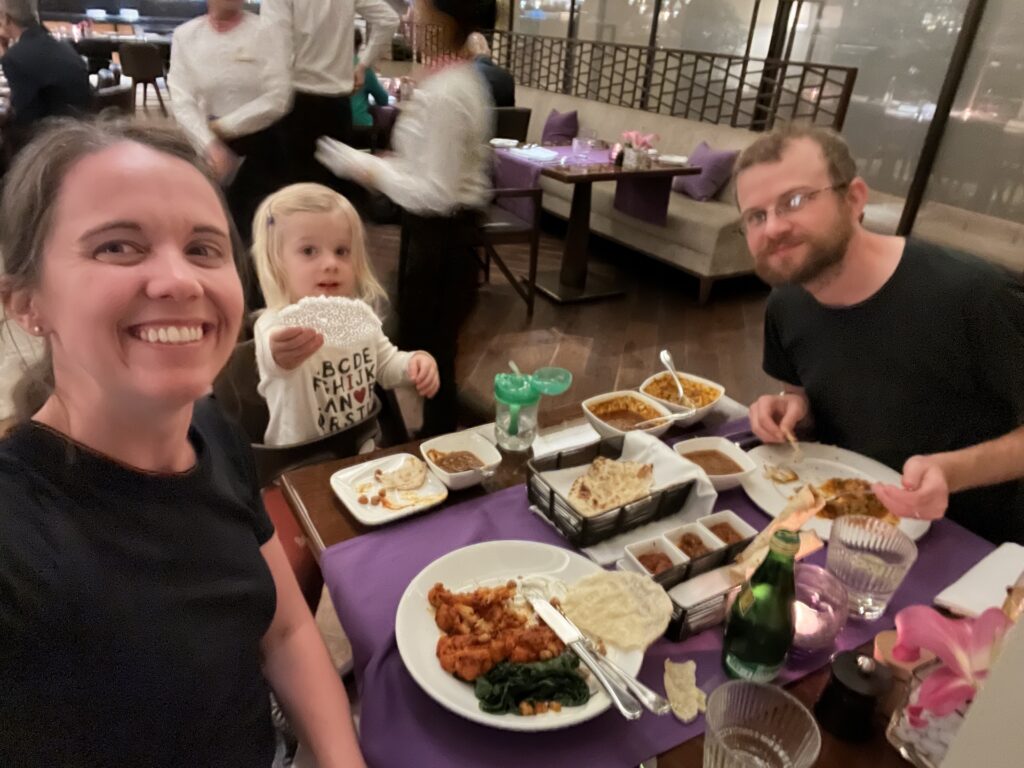
Day 3: Delhi — Old Meets New
While Old Delhi is all windy and narrow streets and alleys, New Delhi is all wide boulevards, massive intersections, and stately buildings. It’s very spread out and much more European than Old Delhi. We had four things on the agenda today and they were all very spread out. We definitely needed a car to get around, so we booked one through our hotel for another 4 hours in the morning.
After another room service breakfast, our driver picked us up at 8 AM sharp. Our first stop was Qutub Minar, which was about a 30 minute drive. This site is one of three Unesco World Heritage sites in Delhi (along with the Red Fort and Humayun’s Tomb), and it is usually described as an old minaret. That didn’t sound that interesting, but I took a chance on it and ended up loving it.
Sometimes in travel, your mood and the weather and the scenery all just line up to make even a simple experience the most special and memorable. I think that’s what happened here. We beat the crowds, it was a cool and overcast morning, my kid had a blast there, and it was just a really great time. Yes, it’s an old minaret, but there’s some really cool ruins and pretty photo spots, and it’s just a lovely place to walk around on a nice morning.
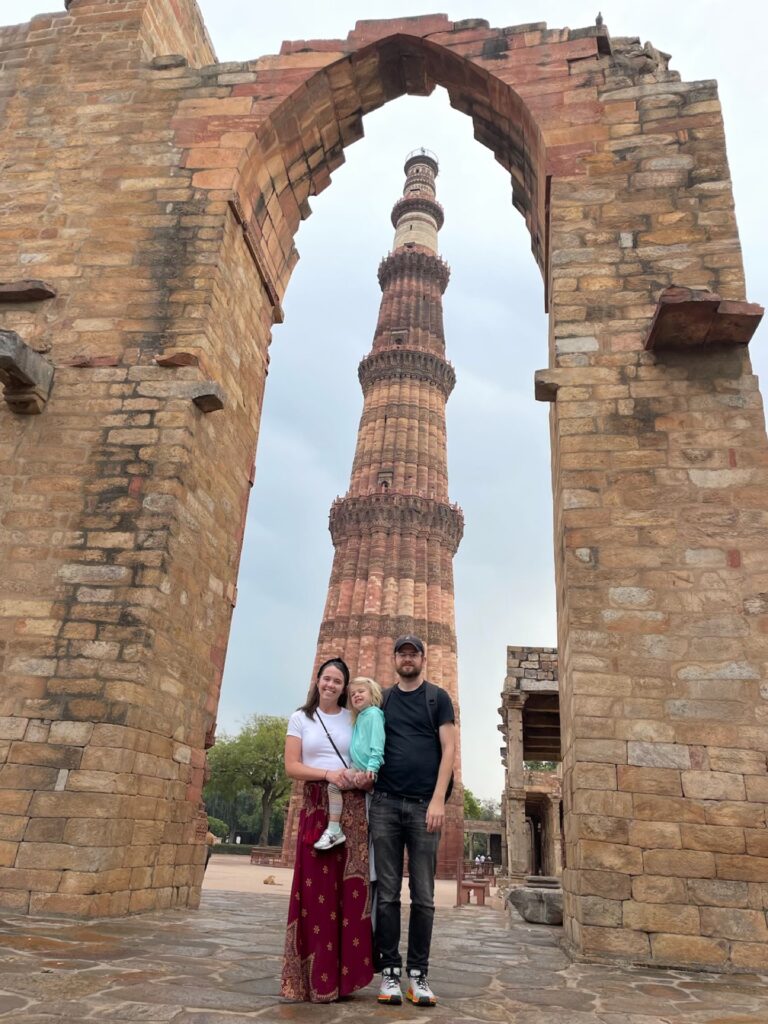
Then we made another 30-minute drive over to Akshardham, which was the complete opposite of Qutub Minar. This is a newly built complex with a large temple, a few exhibitions, and a popular fountain show. It almost has theme park vibes. No phones or cameras are allowed inside and there is very intense airport style security at the entrance.
We wrapped up with two short stops. First was a stepwell called Agrasen ki Baoli. Stepwells are common in India, but most are no longer functional. Like many other stepwells today, this one is now just a quite place to sit and relax. Honestly, I got this one confused with a much cooler stepwell in Jaipur. You don’t really need to go out of our your way to come to this one, unless you want to of course.
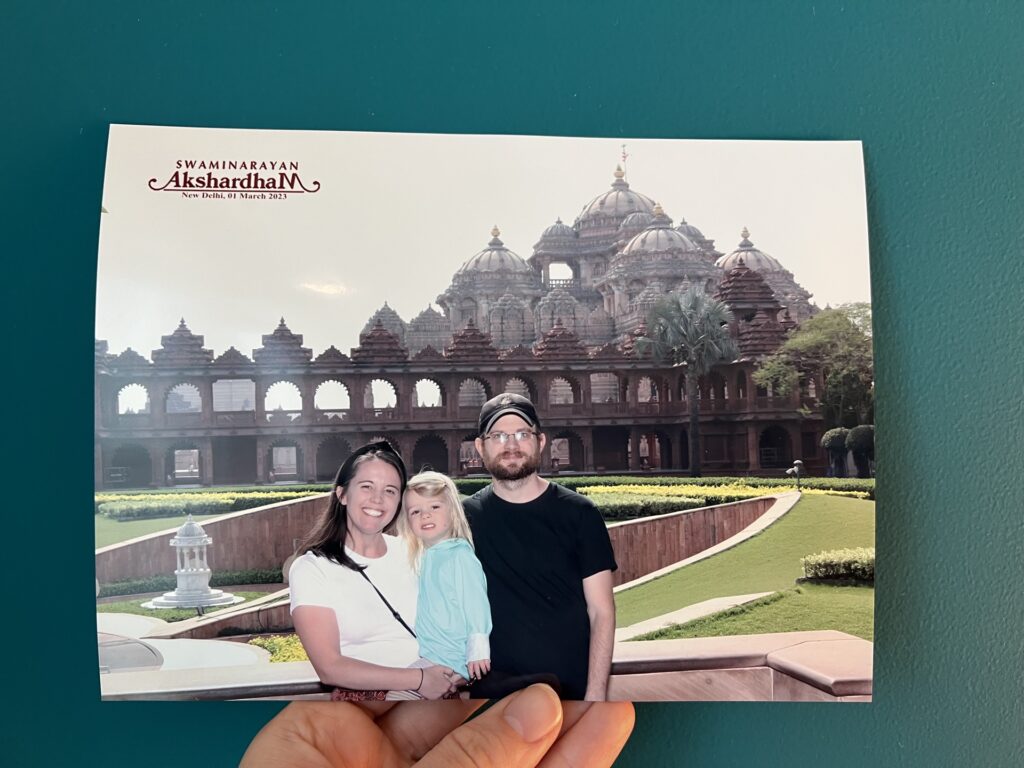
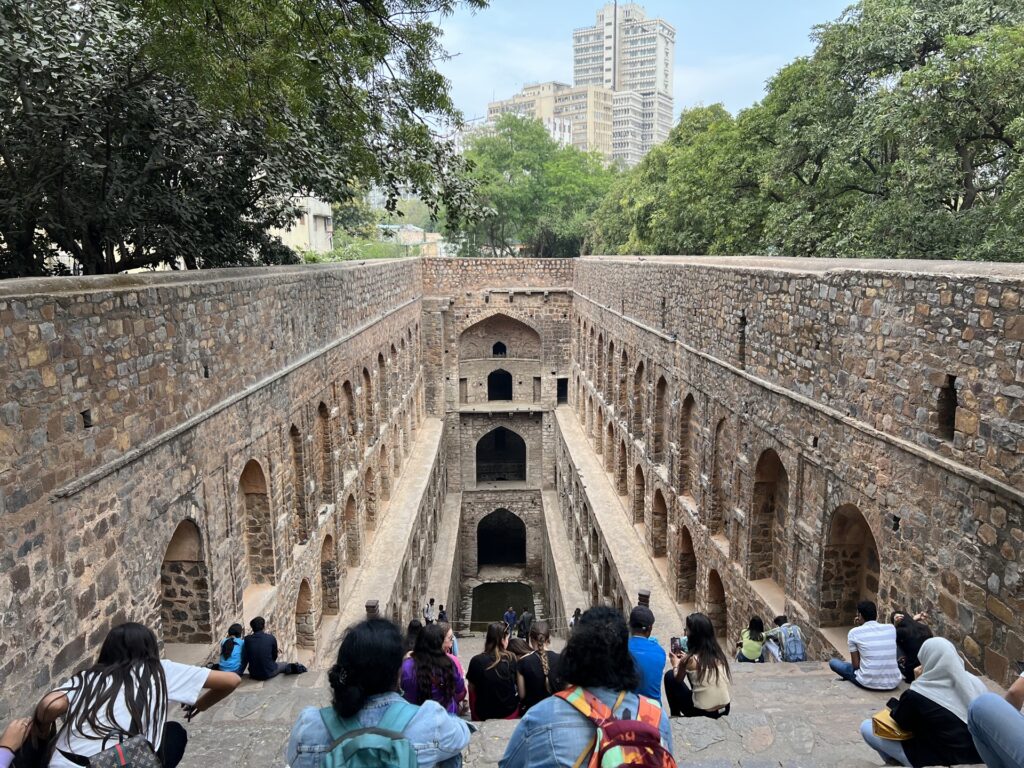
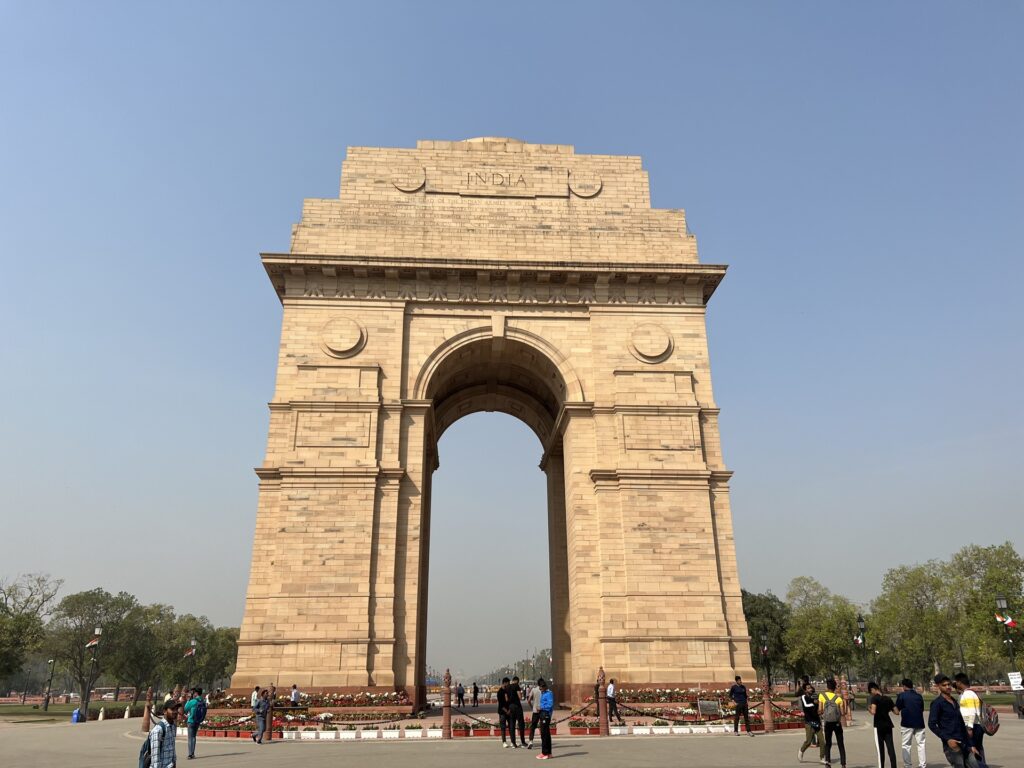
Our last stop was India Gate. This is an Arc de Triomphe-inspired arch in the middle of a large park. I had pictured spending more time in this park, but it was honestly just too hot at this point and we were all pretty hungry. We just snapped a few photos and carried on.
After a full four hours driving around to different sites, we returned to our hotel. Our afternoons were pretty much the same everyday in Delhi. We ate lunch and dinner in the hotel restaurant, where out servers became very attached to our blonde baby. Said baby napped while Kenny and I split time working out or enjoying the hotel amenities. And every afternoon, we spent a few hours in the hotel pool.
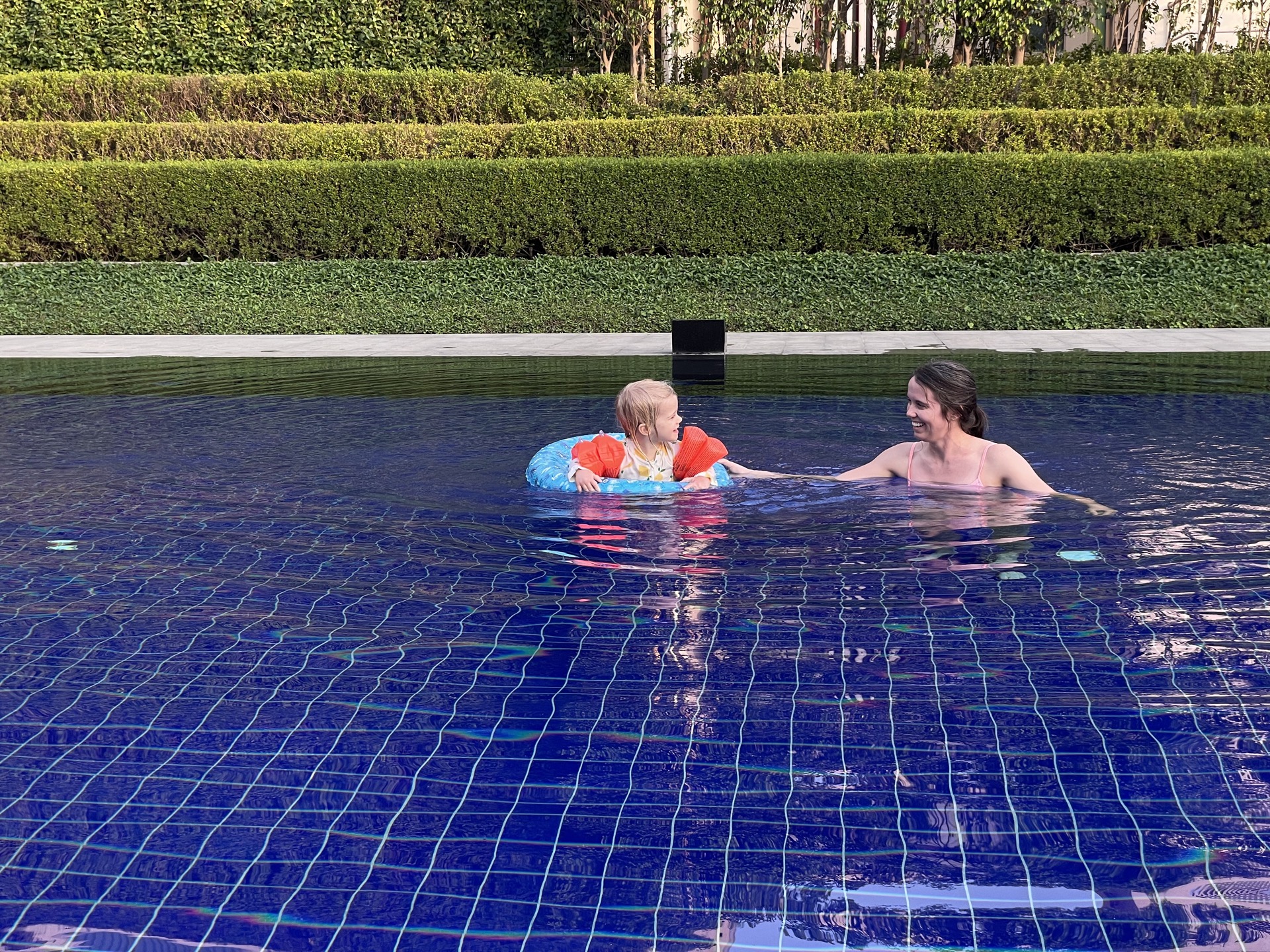
Day 4: Delhi — Tombs & Gardens
The remaining sites on our list were all relatively close to our hotel. They appeared walkable on Google Maps, so I didn’t initially reserve a car for the day. However, after seeing the area in person — the wide streets and hectic intersections and beating sun — we decided the walk was possible but wouldn’t be pleasant. At the last minute, we booked a car for another 4 hours for the morning.
Our first stop was Humayun’s Tomb. The complex opens early (around 6 AM), but the grounds were almost entirely empty during our 8:30 AM visit. Not only did we beat the crowds, but the weather and lighting was perfect in the early morning.
Humayun’s Tomb is another gem in Delhi. It was probably my second favorite place in the city. There are a few tombs in the complex, and we first stopped at Isa Khan’s Tomb. It’s smaller and built in an entirely different style than Humayun’s, but I loved it for the way the gates framed the tomb.
On the way to Humayun’s Tomb, we passed through West Gate. I read that you could go to the top of the gate for great views of the tomb. Now, I did weasel my way up to the top, but I’m not sure that was actually allowed. I took a quick photo and then hurried back down.
You can go up and inside Humayun’s Tomb, which we did. The view from the top was nice, but inside is mostly just empty stone rooms. Still cool though. There are a few more tombs in the area, but we headed out after seeing the two biggest.
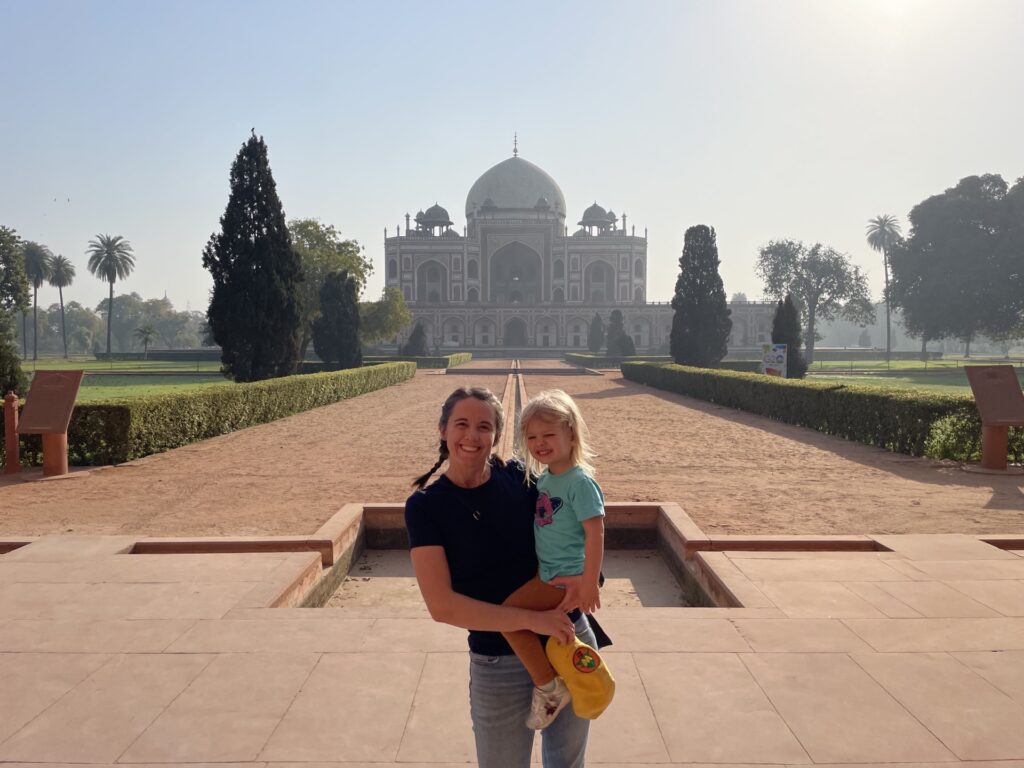
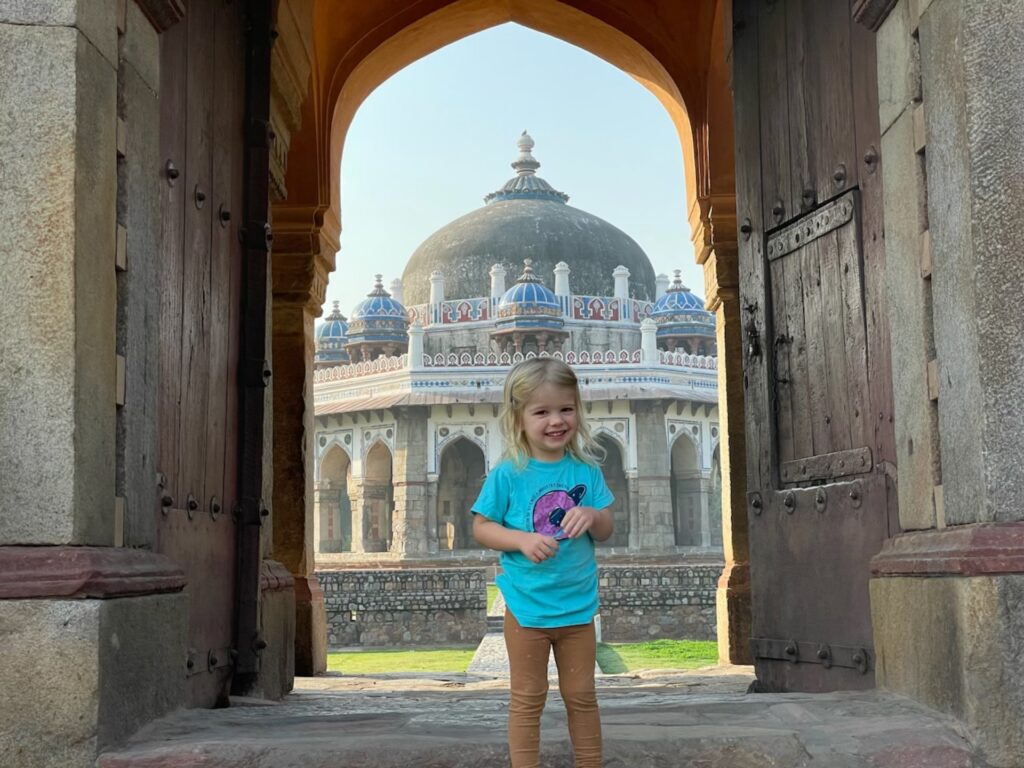
Next was Safdarjan tomb. At first glance, this tomb seems like it would be just as stunning as Humayan’s. But when you look for too long, you notice that it’s not quite right. The proportions are off and the materials are a much lower quality. Not knowing that it was a B-Lister at the time, I still had a nice walk around it.
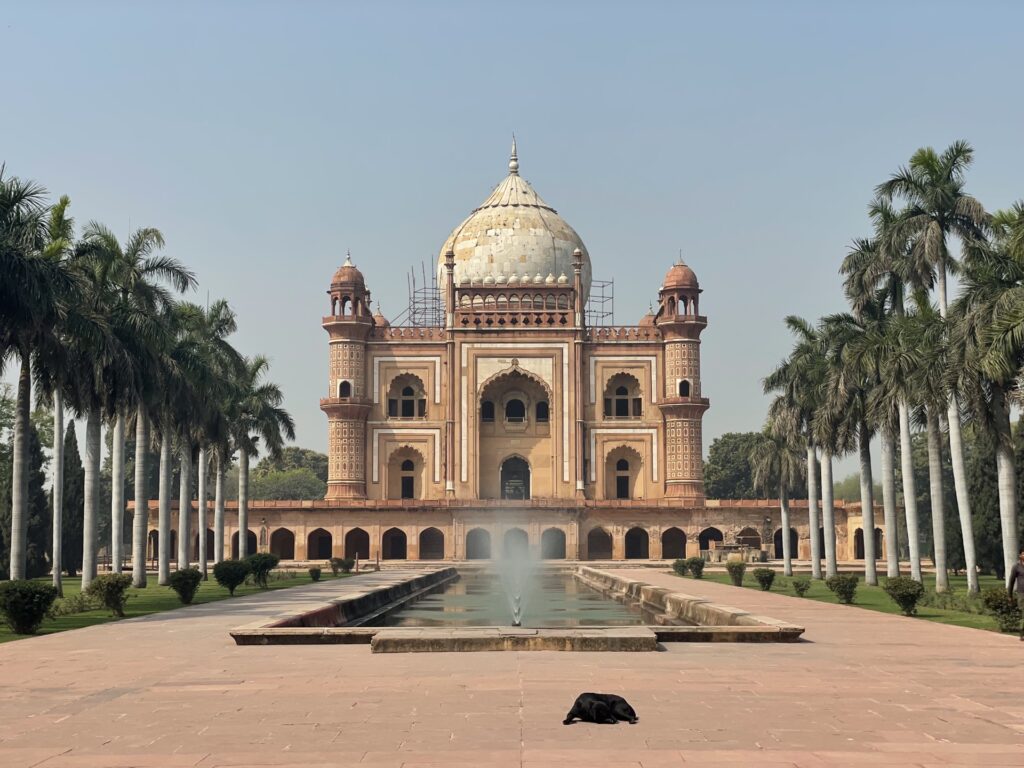
We finished our morning at Lodhi Garden. Everyone loves Lodhi Garden. It is a true oasis in the city. It’s a large garden park that is dense with trees and gardens, large green lawns, a pond, and even some tombs (this is still Delhi after all). It’s a peaceful and quiet place to escape the business of the city … as long as you’re not getting chased by massive bugs like we did at the end.
We could have stayed at Lodhi Garden for much longer, but lunch time was approaching and our time with our driver was ticking by.
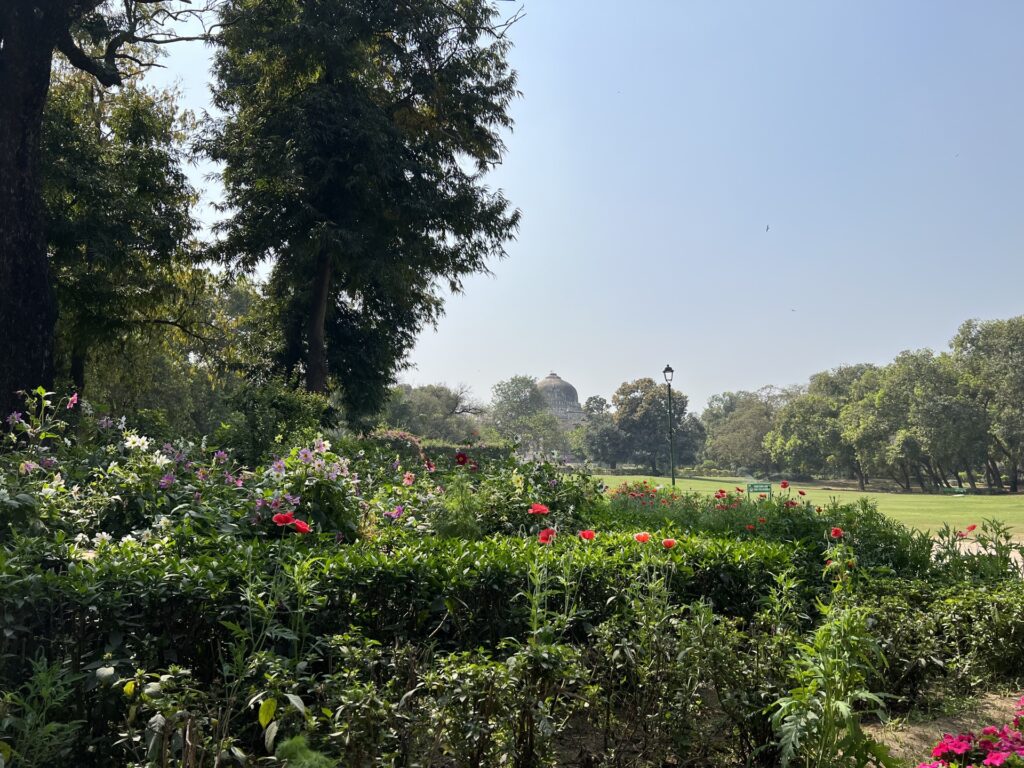
As was had grown accustomed by now, we spent the remainder of our day napping, swimming and eating at the hotel restaurant. Tomorrow was a travel day, so we also took some time to pack.
Day 5: Travel from Delhi to Jaipur
Jaipur is about 185 miles southwest of Delhi. You can get there by train or car. The train times vary based on the schedule and can range from 3.5 hours to 8 hours. The shortest train is in the evening (6:40 – 11:05 PM), but that was a little later than we wanted to do with a toddler.
We decided to book a car for the Delhi-to-Jaipur leg. Our driver picked us up at our hotel in Delhi at 8 AM and we checked into our new hotel in Jaipur around 1 PM. This included a 30 minute stop where our driver kind of just disappeared and left us at a rest stop. (Not unsafe, just a little boring. We did get to scope out some of the local chip flavors though.)

Our hotel in Jaipur was the Jai Mahal Palace. After being shown to our room, we grabbed lunch at the Italian restaurant on property before getting in a quick nap. We spent the rest of our afternoon and evening swimming in the pool, playing in the kids room and walking around the gorgeous grounds. The restaurants in this hotel were much fancier than our last, so we decided to just have room service for dinner.
If you were short on time, you certainly could have ventured out into the city to explore on the second half of your travel day. Our hotel wasn’t within walking distance to anything interesting, so we had no problem relaxing the afternoon away.
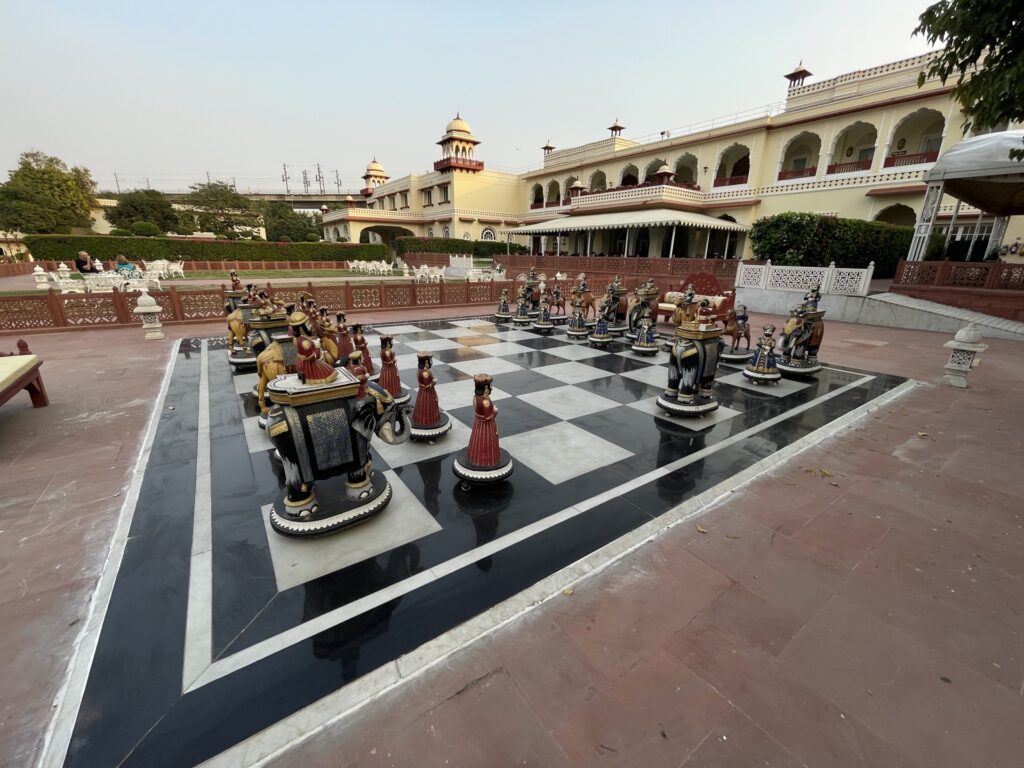
Day 6: Jaipur — Forts & Palaces
NOTE: We have a full Jaipur Itinerary that’s packed with detailed information about each of these sites plus even more things to do.
Jaipur is the capital of Rajasthan. This Indian state is what a lot of people probably picture when they think of India. Rajasthan is known for its elaborate forts and palaces, unique cuisine and brightly colored traditional dress. Rajasthan is one of the most beautiful parts of India and one of the most popular tourist destinations.
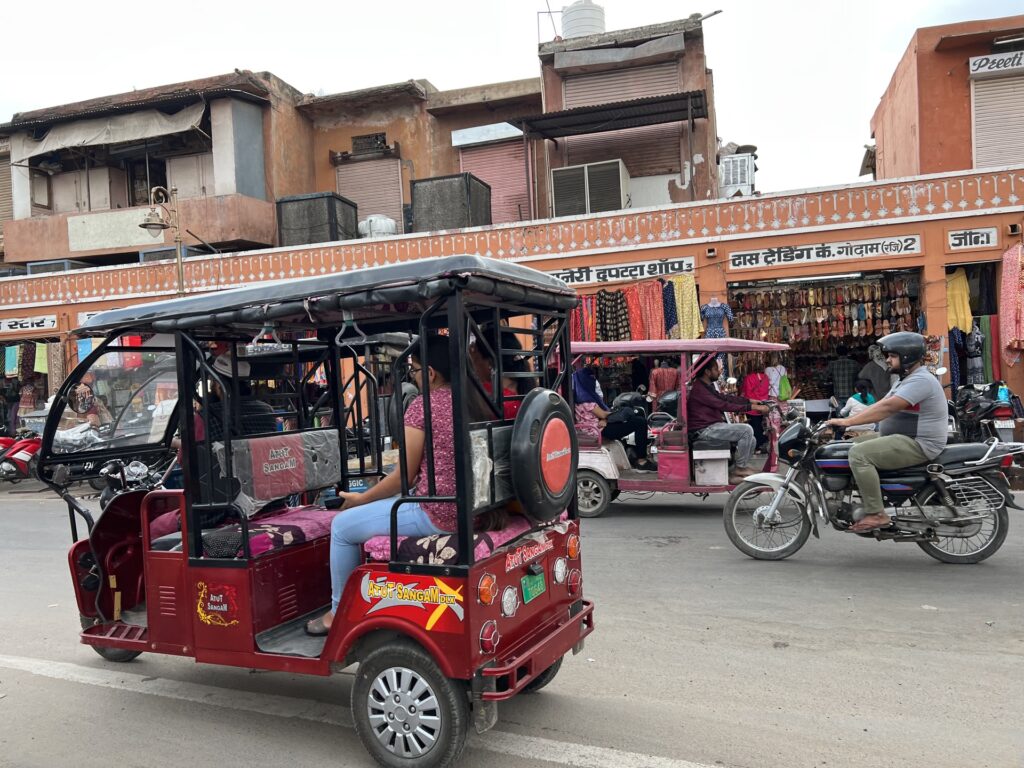
The Old City in Jaipur is very walkable, but to get to the forts up in the mountains you will need a car. We decided to book a car (with a driver) for a full day.
We started our day at Amer Fort, the most impressive fort in the city. It’s a good idea to get here right when they open because this fort gets really crowded, really fast. There are many beautiful spaces in the fort, which makes it a popular spot for local couples and influencers alike to come for professional photos.
Our next stop was Panna Meena ka Kund, which is a very intricate and stunning stepwell. (This is the one I was picturing when I made us stop at the other one in Delhi.) This is a quick stop, but one you should absolutely make! You actually pass it on the way up to the Amer Fort, so if you have time, you should stop here before the fort.
Next, we went over to Jaigarh Fort. Despite looking close together on the map (and being walkable via a pedestrian tunnel), it actually takes quite a bit of time to drive between the forts because of how the mountain roads are laid out. The fort itself is nowhere near as impressive as Amer Fort — Jaigarh Fort was the military arm while Amer Fort was the royal residence — but the views from Jaigarh Fort are better, which makes it worth it. (Also, we saw monkeys here, which is always fun.)
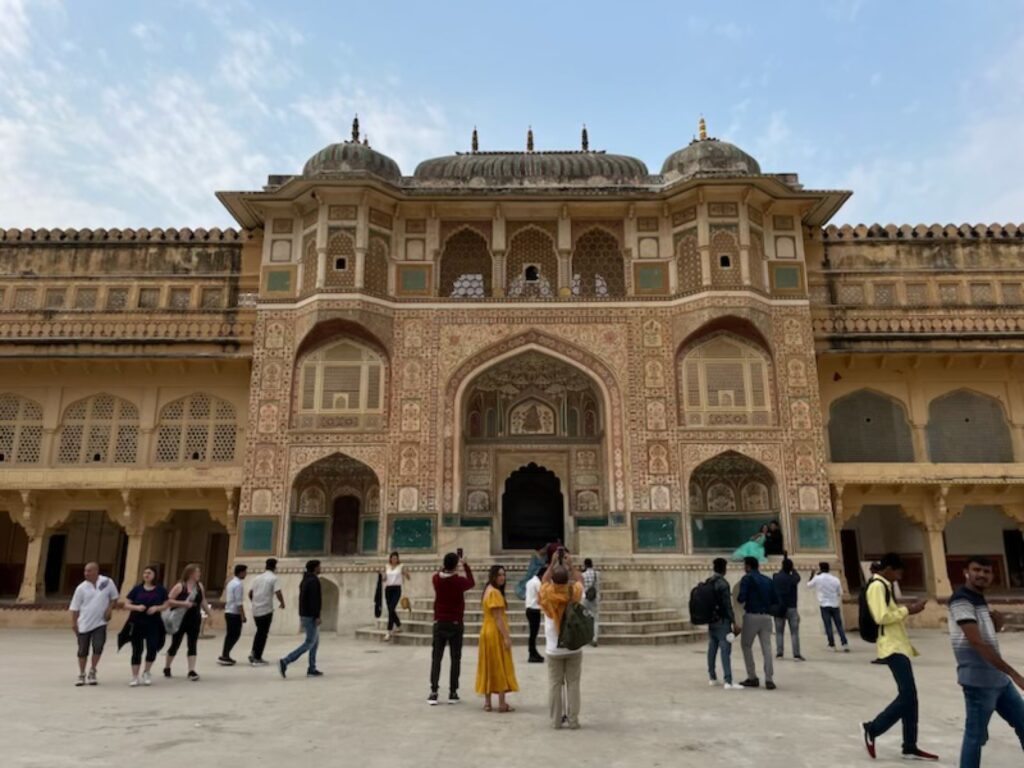
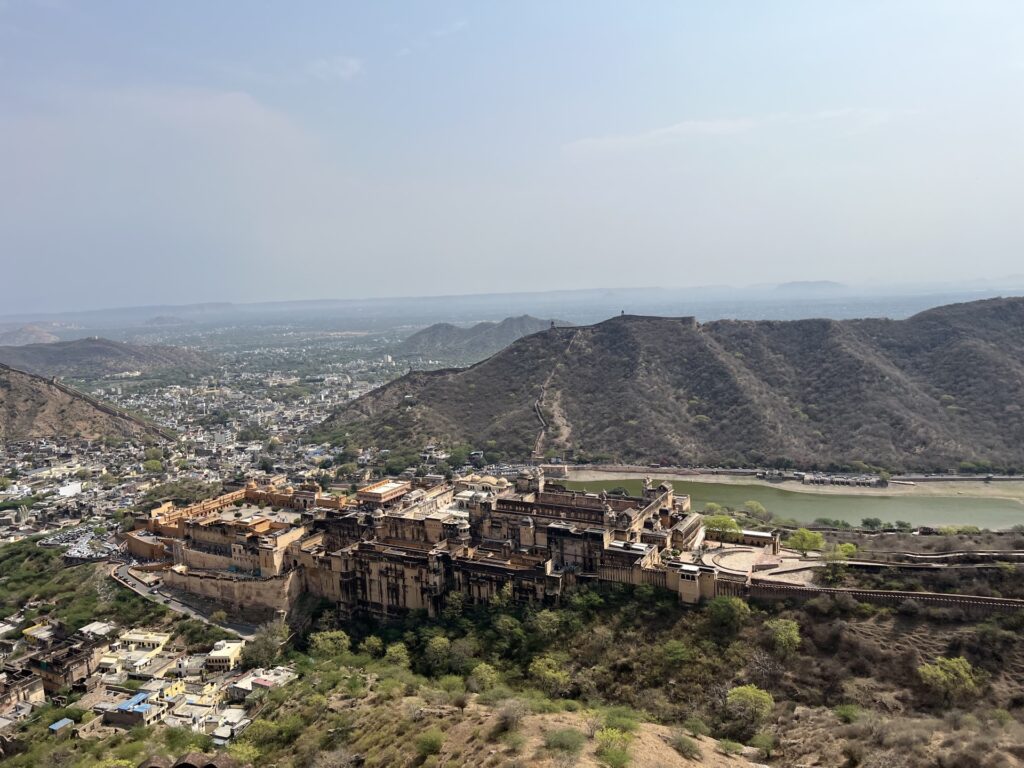
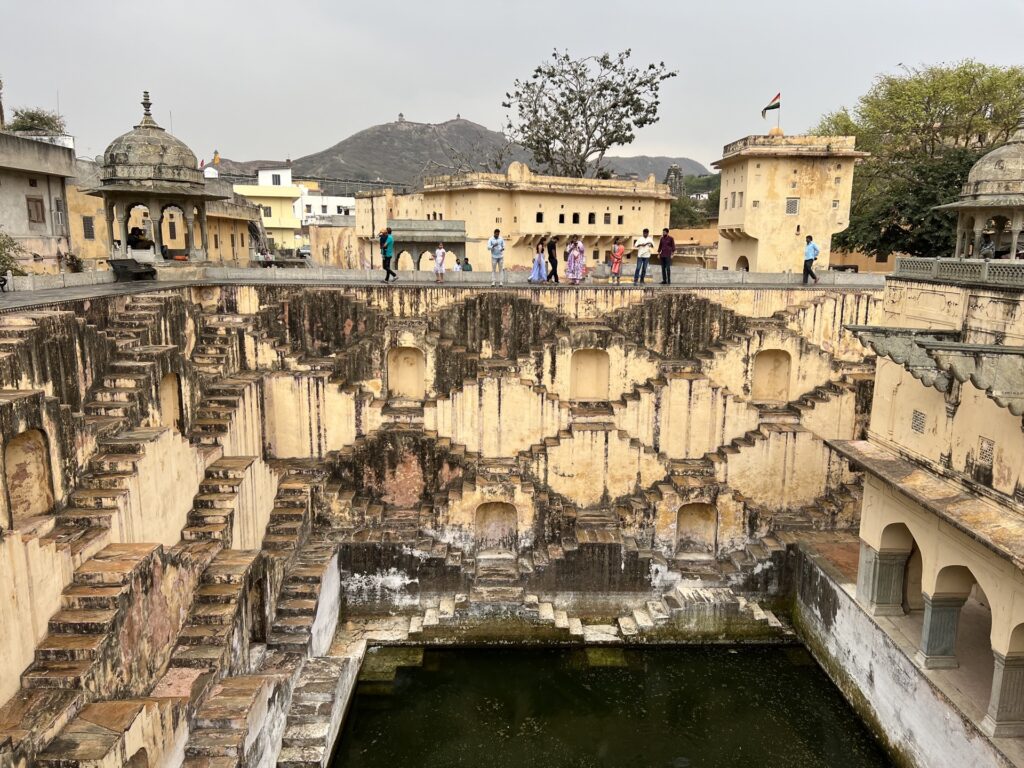
By now it was time for lunch. Rajasthan is famous for Thali, which is a serving style that comes on a large tray filled with small bowls of different dishes. We really wanted to try authentic Thali, so we decided to have a rare meal outside of our hotel.
Zeeman Restaurant has 4.6 stars on over 200 reviews, so we went for it and we did not regret it! It was so good, we did not get sick, and we were happy to have the chance to try some locally made Indian food at least once. (It was out of the way to come back to this restaurant from Jaigarh Fort. If you’re hungry after Amer Fort, it makes more sense to eat before you go to Jaigarh Fort.)
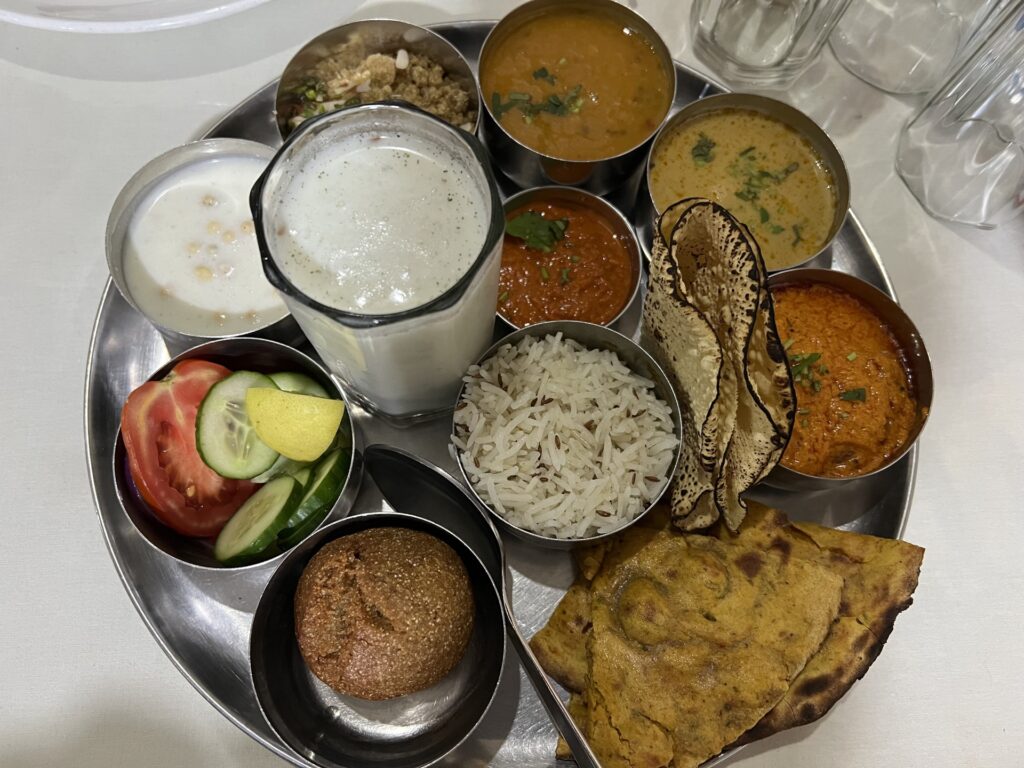
One our way back to town from the mountain forts, we stopped at Jal Mahal. This palace was intentionally flooded and is now a little island in the middle of the lake. You can only see the palace from the land and there’s a street market that lines the shores near the palace. Our toddler bought a cheap slinky, but we otherwise just took a picture and left.
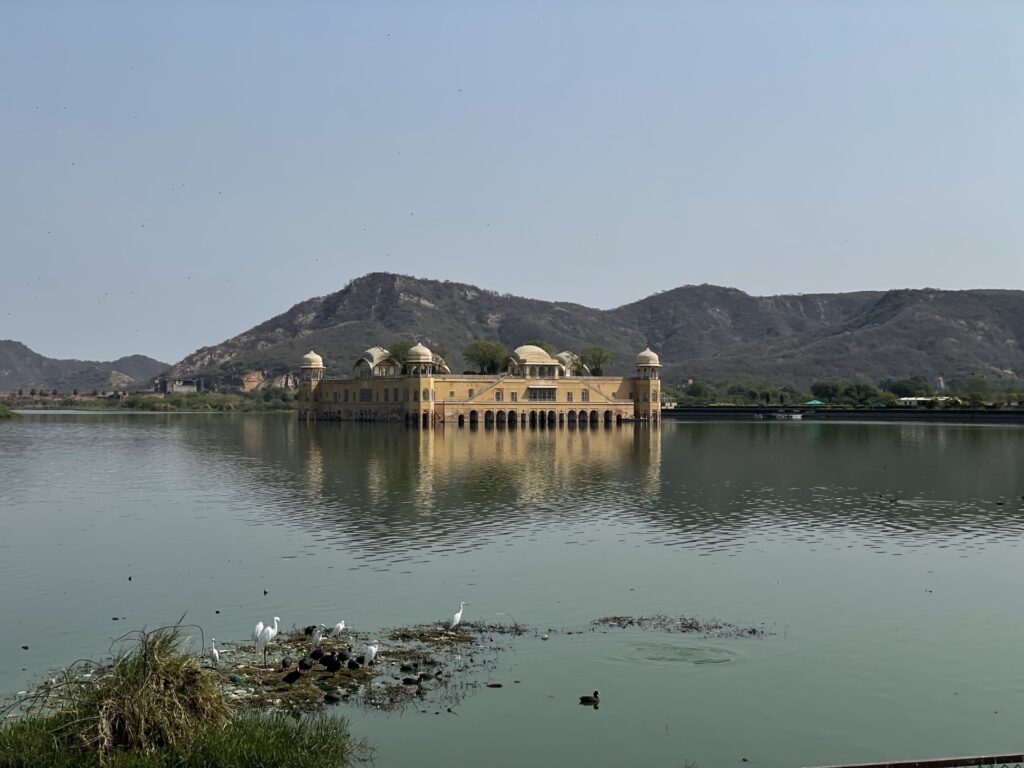
From here, we personally continued on and did all the things listed on days 6 and 7 in a single day. We opted for one full day of sightseeing and then spent the entire next day resting at our hotel. This is a fine option if you want a rest day, but it did make things pretty rushed. We’d suggest doing the following activities on a separate day. You can even fit in a few more things that way, and take it at a slower pace.
Day 7: Jaipur — Jaipur Old City
Most of Jaipur’s Old City is very walkable. Once you get to the area, you won’t need a car. To get there from your hotel, you can hail a tuk tuk, take an Uber or even take the Metro if you’re by a station.
If you’re doing Jaipur City on a separate day than the forts, start at City Palace. Get there when they open at 9:30 AM to beat the crowds. We didn’t make it here, and it generally gets mixed reviews, but I think it’s worth seeing if you have the time.
After the palace, walk over to Jantar Mantar. (This is where we went after Jal Mahal.) It’s an open-air observatory that was built in the 1700s. You can walk by the massive manual star-tracking instruments and learn about how they worked. Though not a must-do, it’s interesting and pretty. You can get a composite ticket that includes Jantar Mantar and the City Palace, plus some other places.
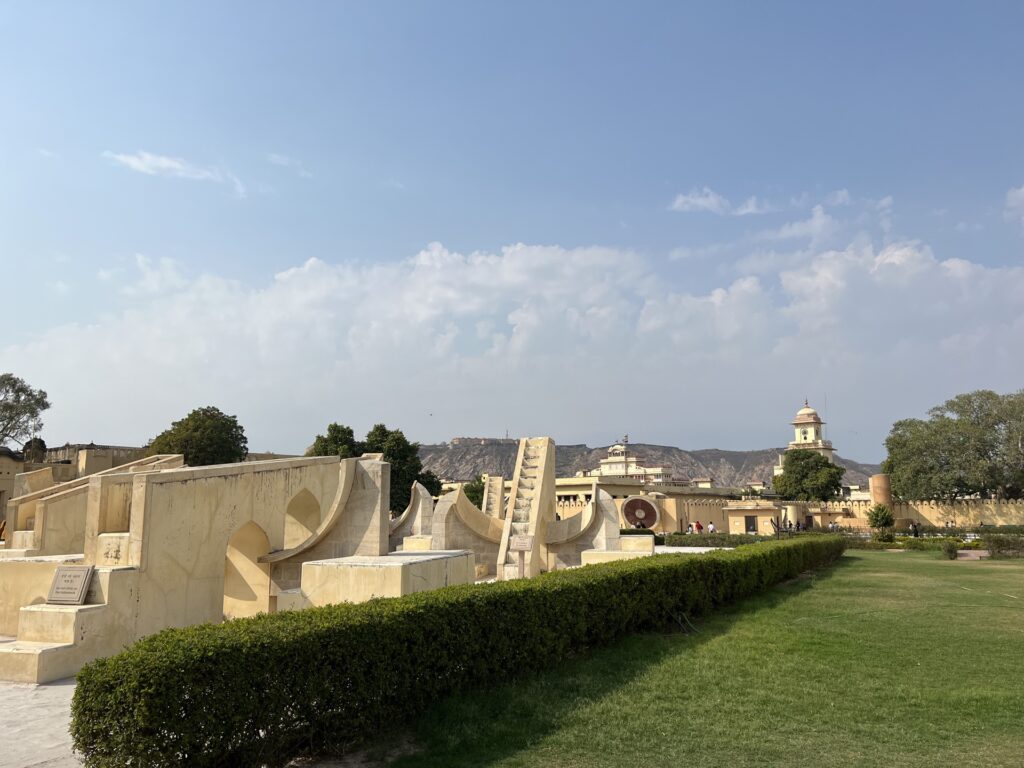
We left the walled city and went south on Chaura Rasta Road to Bapu Bazaar. This walk isn’t overtly exciting in the tourist sense, but it does pass many shops and stores that the locals actually shop at (like small hardware stores, school book stores, etc). It was cool to see the non-touristy (eh, less touristy) side of Jaipur.
Bapu Bazaar extends about three blocks from Chaura Rasta Road to Johari Bazar Road. It’s a lovely market that is as much for tourists as it is for locals. They sell clothes, souvenirs, shoes, fabric and so much more. It’s a colorful, noisy and beautiful walk.
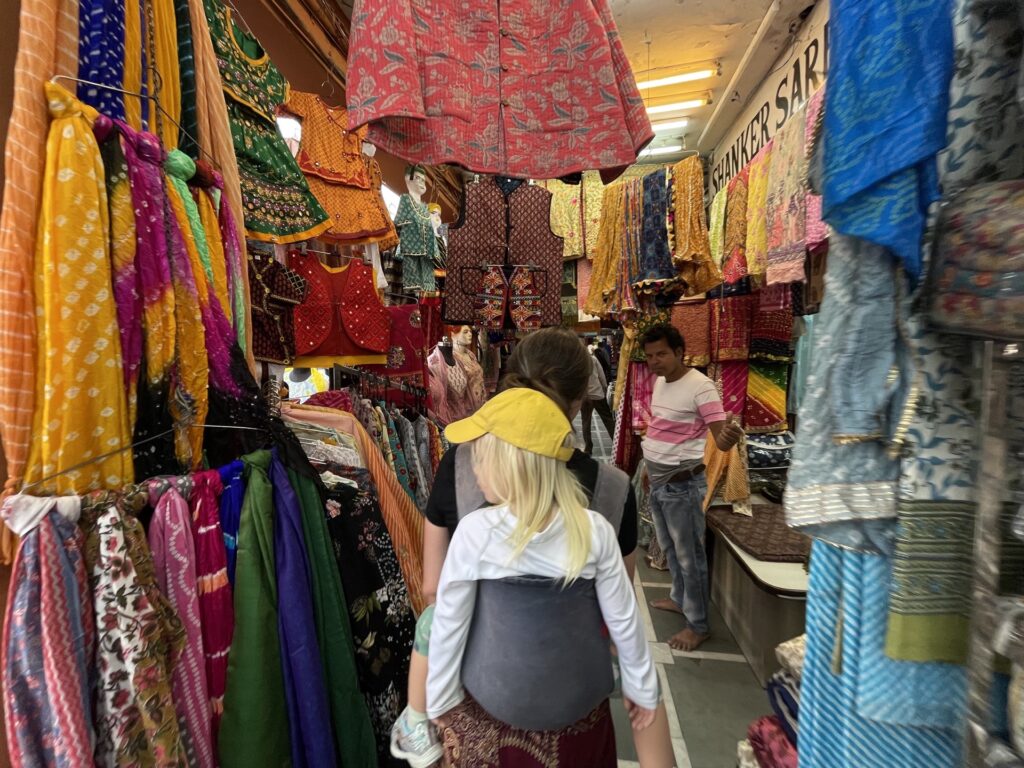
When you get to Johari Bazar Road, head back north (turn left). This is another bustling market street but with more stores than stalls. Before you get back to the walled city, you’ll pass a massive traffic circle called Badi Chaupar. Be careful crossing here, and then take a minute to watch the traffic. It’s amazing to see all colorful tuk tuks zooming in and out of here.
We finished our time in Jaipur at the city’s most famous landmark: Hawa Mahal. This building is most famous for its facade, which has become the symbol of the pink city. You can go inside, but most people don’t. The best views are from across the street. Lots of people also recommend an elevated view from the restaurant across the street, The Tattoo Cafe & Lounge.
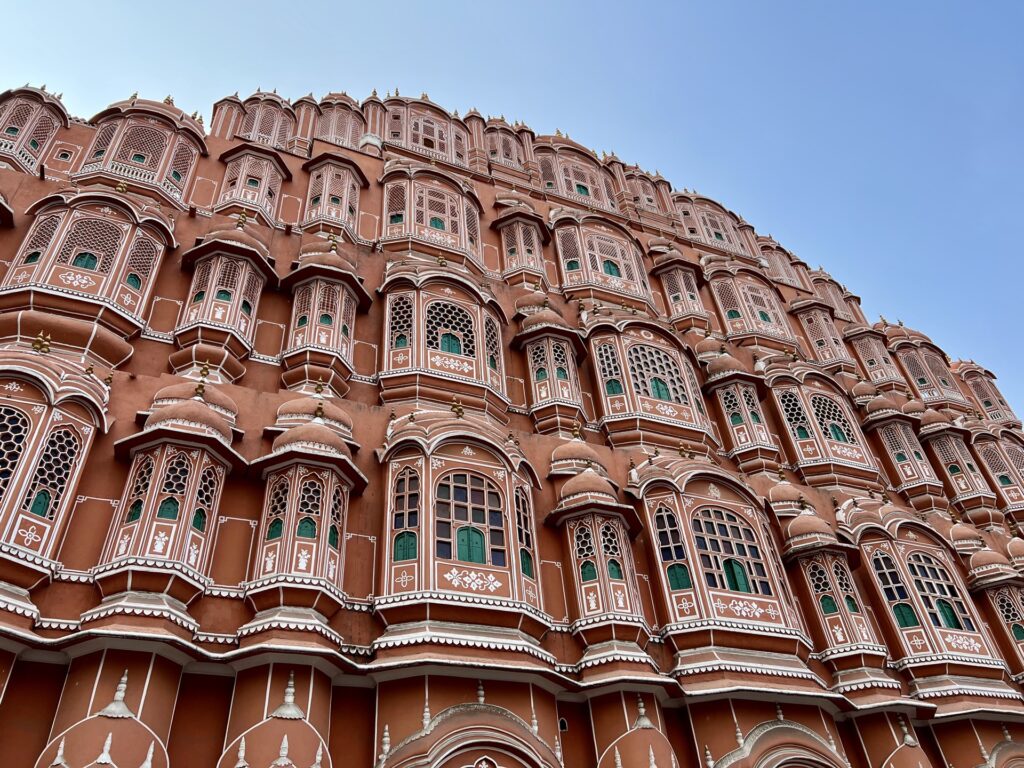
Day 8: Travel from Jaipur to Agra
The Jaipur to Agra leg of the Golden Triangle is probably the most annoying. There are a handful of trains, but only one that is scheduled for a reasonable time (8:10 AM – 12:30 PM). Alternatively, you can hire a driver which will take about 5 hours.
If we were just doing the Golden Triangle, we would have probably taken the 8:10 AM train. Our hotel in Jaipur was close to the train station, so we would have had scheduled an early car service to get us there on time.
We had some extra days, so we actually inserted a trip to Udaipur between Jaipur and Agra. We took an early day train from Jaipur to Udaipur. After spending a few days in Udaipur (including celebrating Holi in Undaipur), we then took an overnight train from Udaipur to Agra.
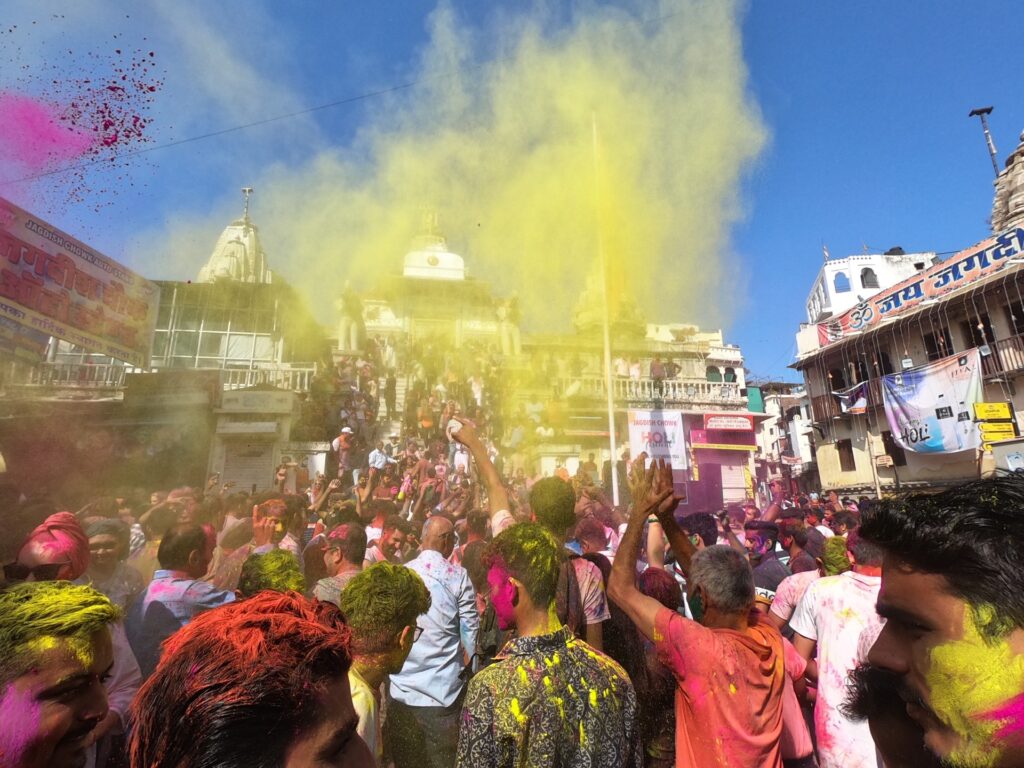
For the sake of this itinerary, what matters is that you get to Agra in time to spend at least one morning at the Taj Mahal.
Day 9: Agra — Taj Mahal
The Taj Mahal. Your journey to India and around the Golden Triangle has lead you to this moment. I was very excited to see the Taj Mahal and it did not disappoint. It was majestical and breathtaking and serene, and everything you probably imagine it to be.
The Taj Mahal is most beautiful at sunrise. If you’re staying in Agra, I’d highlight recommend getting up early for sunrise. You won’t beat the crowds, but you will be the heat.
Speaking of crowds, the Taj Mahal is incredibly popular and crowded. If you have your heart set on a photo with a completely empty backdrop, you’re going to need to get in line around 3 AM. However, if you don’t need “the shot” plan to get there about 30 minutes to 1 hour before sunrise. That should give you enough time to get through the security queue and onto the grounds in time to see the sun come up.
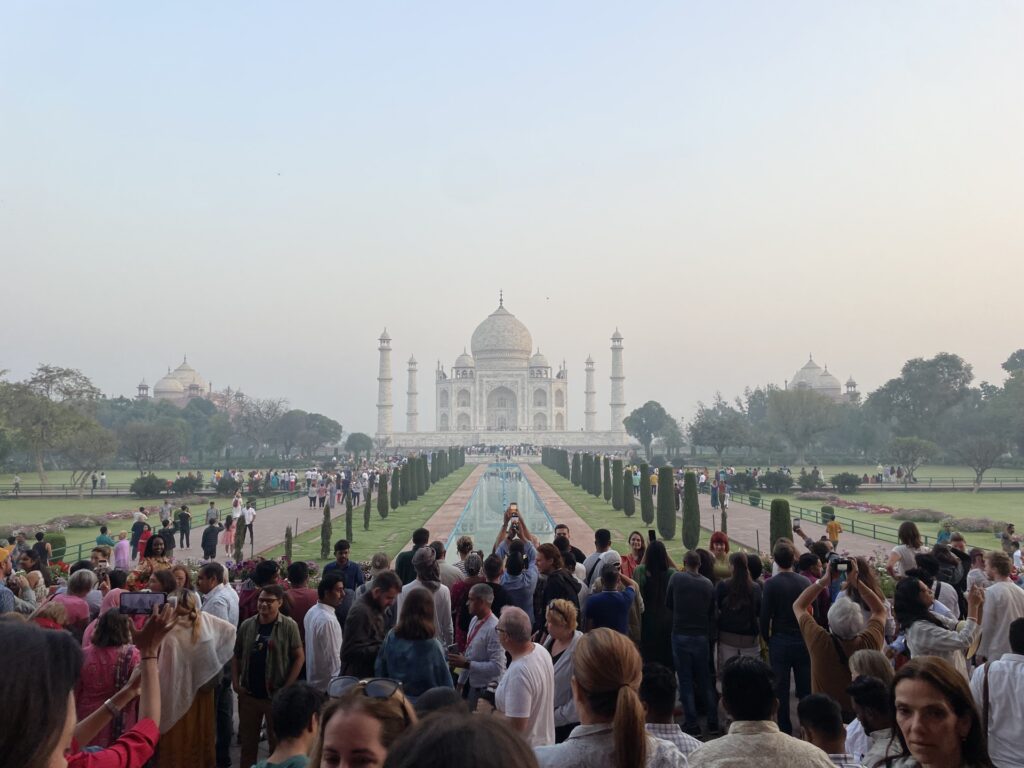
The main photo spots, like just inside the entry gate and the iconic bench in the middle of the waterway (which has a formal, Disney-style queue for it) get very crowded. However, there are plenty of beautiful viewpoints around the grounds that don’t have lines or crowds. Even during the busiest time of the morning, we easily grabbed all of these photos with no waits.
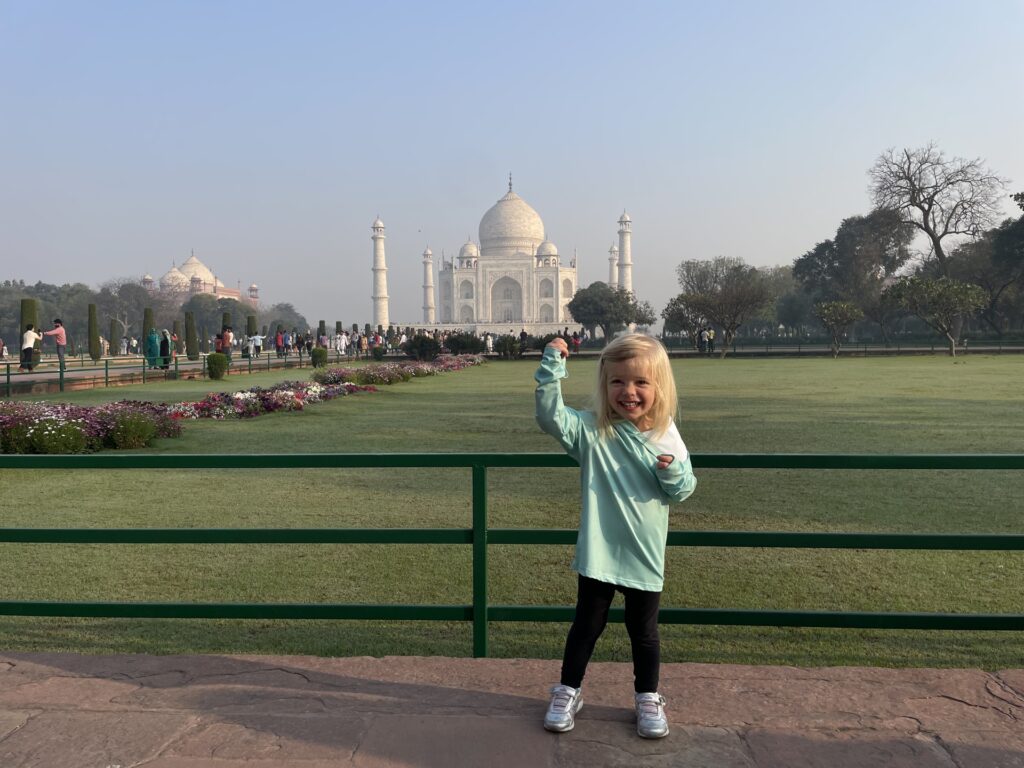
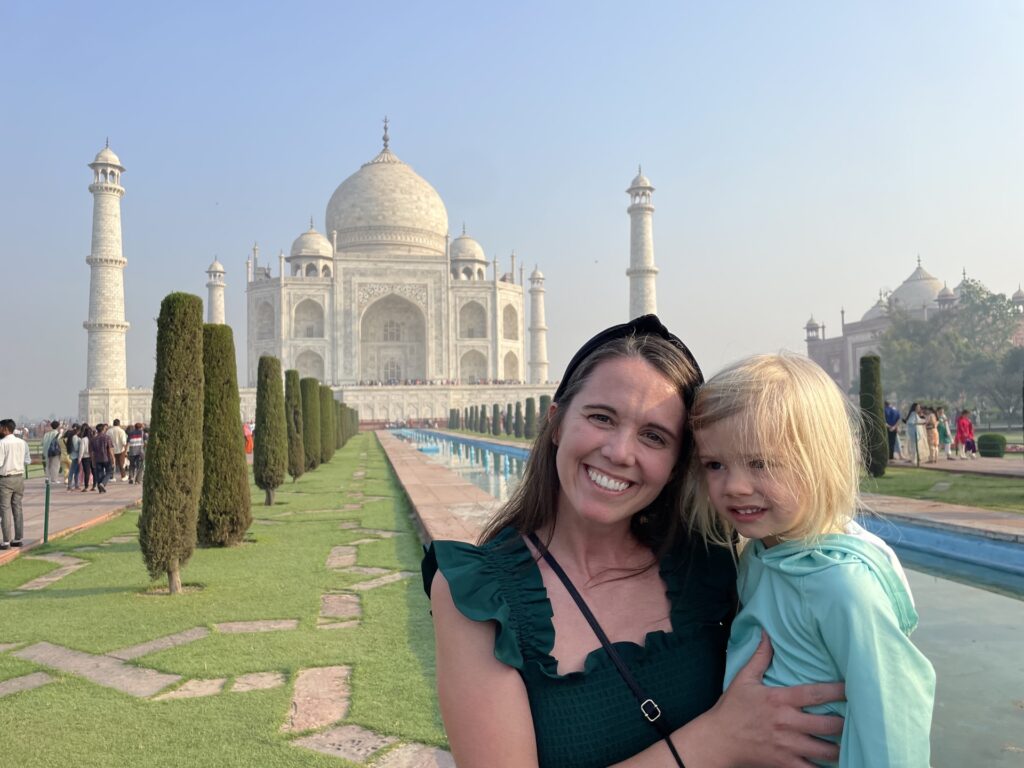
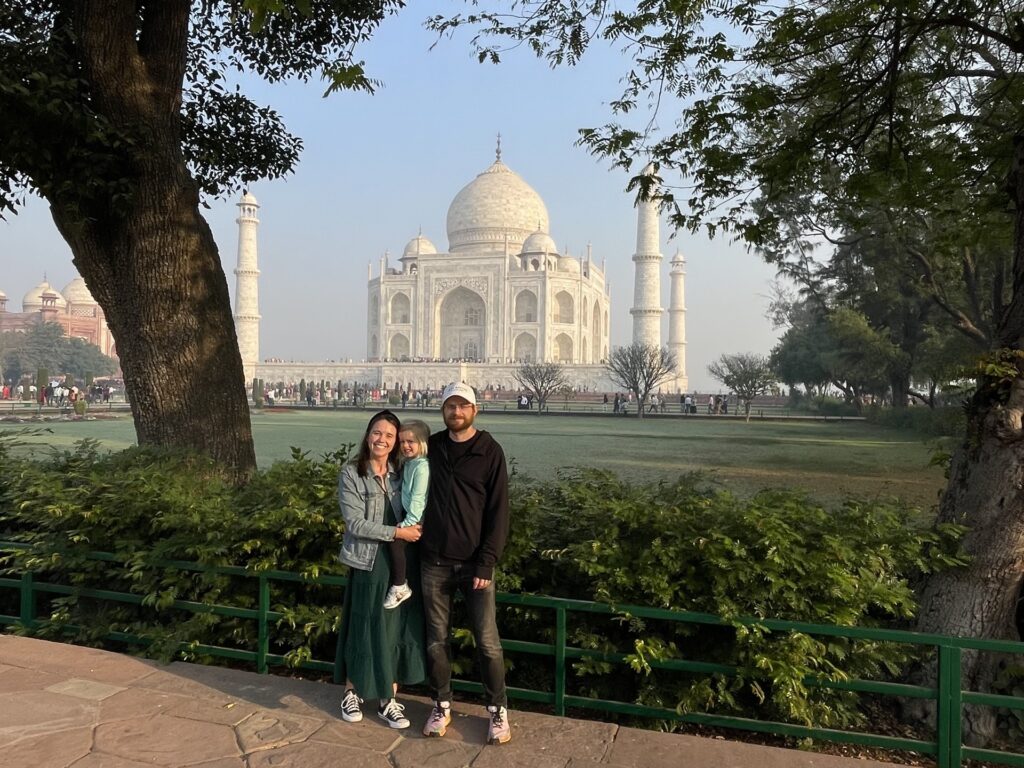
The Taj Mahal is a mausoleum, and you can go inside. However, you can only view the main floor, which is a replica of the actual tomb which is a floor below. The inside of the Taj Mahal is not actually that noteworthy, but you still have to do it. It’s the Taj Mahal!
Many hotels offer tour guides for the Taj Mahal. We hired one, but I don’t think that a tour guide is necessary for the Taj Mahal. Our tour guide was very knowledgeable, but he didn’t tell us more than we could have learned from reading wikipedia for 20 minutes. The experience is more about seeing and being at the Taj Mahal, and I would have preferred not to feel rushed or tied down to a guide.
We spent about 2 hours at the Taj Mahal. If we didn’t have a kid, we might have hung out for another hour or so. Afterwards, we returned to our hotel in time for breakfast and then spent the rest of the day swimming in the pool and enjoying the view from our hotel.
Our hotel room had a balcony with Taj Mahal views and it was truly incredible. We got to appreciate this incredible building for the entire duration of our stay in Agra, not just the morning we spent on the grounds. I know that this is not in everyone’s budget, but if it’s in yours, I cannot recommend it enough.
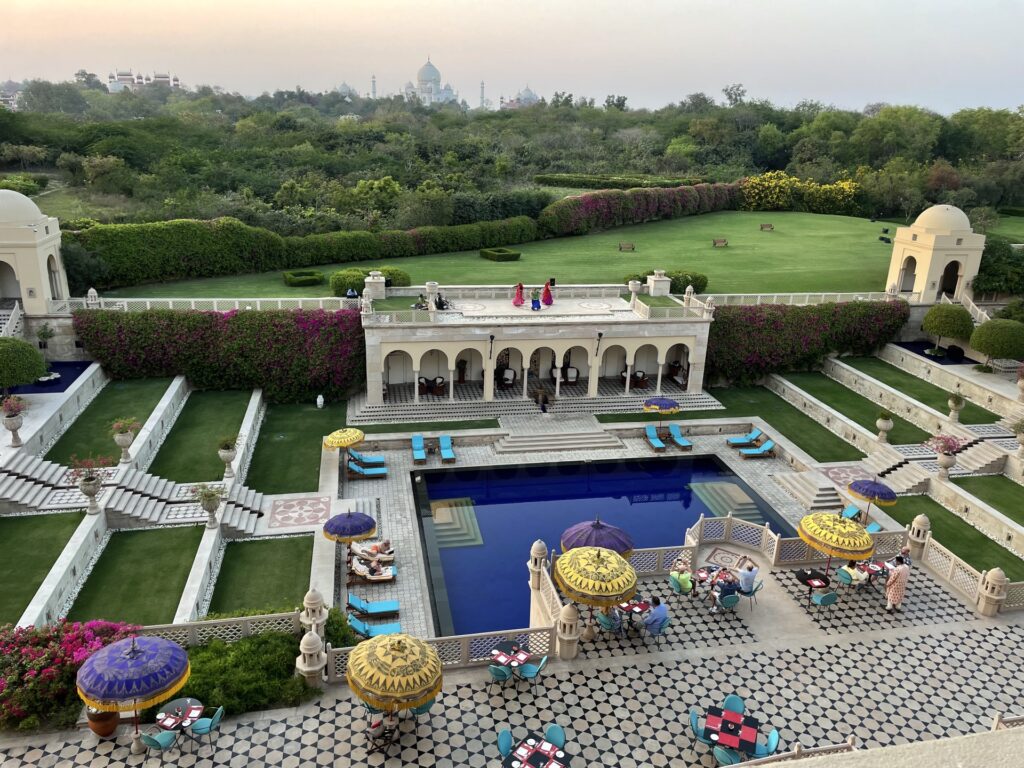
If you wanted to keep busy, Agra Fort is the other main attraction in Agra. You’ll need to take a car or tuk tuk there. There’s not much else you really need to see and do in Agra, so 1 full day there is really enough.
That said, there’s always the chance that you get hit with some bad weather or it’s foggy in the morning or your alarm doesn’t go off. If something goes wrong during your visit to the Taj Mahal, it it could be nice to have a backup option. That’s really the only reason I would suggest staying multiple nights in Agra.
Day 10: Return to Delhi and Depart
The final day on this itinerary is a bit flexible and depends a lot on your flight schedule.
The train from Agra to Delhi takes 2.5 – 4 hours, depending on the route and schedule. Not all of the times are great, but there are some morning schedules that can get you back to Delhi pretty early.
This is fine if you have a late flight out, however it can be a bit nerve-racking to be relying on a train to get you back in time for an international flight. If you want to take the train, you might alleviate some of that stress by taking the train back to Delhi in the afternoon or evening after your visit to the Taj Mahal.
Another option is to take a car. It takes about 3.5 – 4 hours to get from Agra to the Delhi airport. If you left early on your final day, you should comfortably make an afternoon flight.
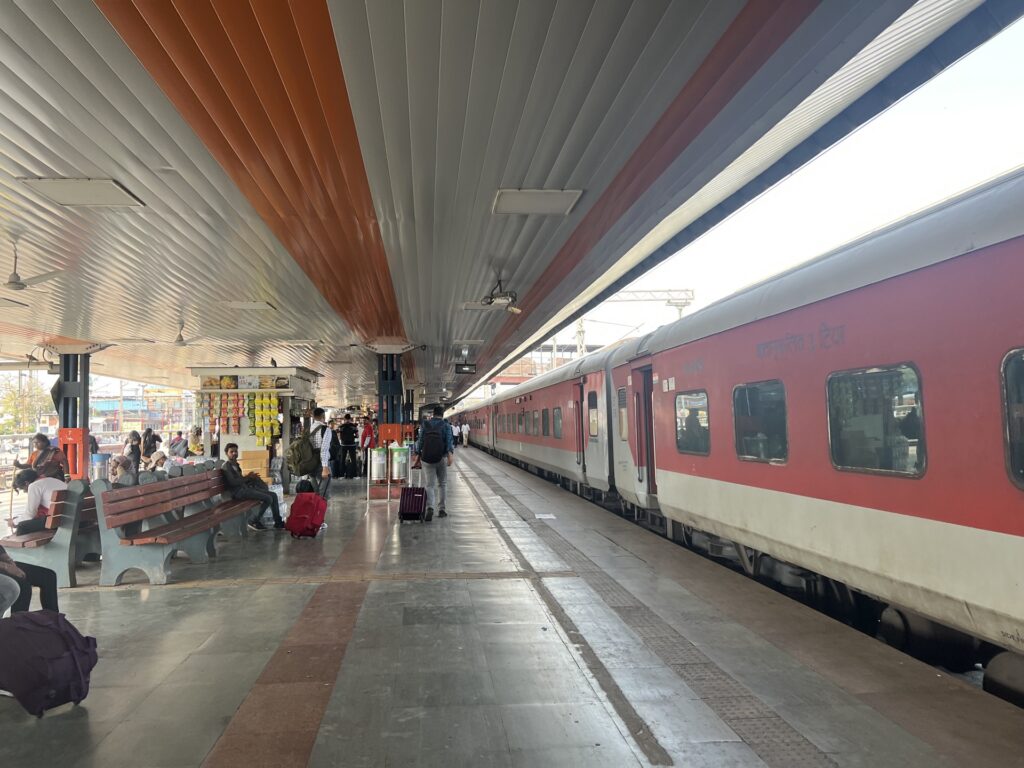
We took a midday Kerala Express train from Agra to Delhi, and then took the Metro to Aerocity. We spent one night at the airport hotel (JW Marriott New Delhi Aerocity) and then flew out early the following morning.
However you get back, be sure to give yourself plenty of time at the Delhi airport. After all the lines and check points, it took us about 2 hours total from the time we arrived at the airport to the time we got to our gate.
10 Tips For Visiting the Golden Triangle
- Visit attractions early in the day. This is generally a good way to beat the crowds and its always a good way to beat the heat. There are a lot of domestic Indian tourists on the Golden Triangle and they tend to come out in full force in the afternoon. (The exceptions are the Taj Mahal and Amer Fort, which were both crowded even at opening.)
- Watch out for anything that touches tap water. “Don’t drink the water” is common knowledge in India, but watch out for the sneaky ways tap water can get into your system. Don’t brush your teeth with tap water, don’t consume raw fruits and veggies that may have been washed with tap water, be cautious about what coffee and tea you consume, etc. We always had bottled water on us or used this water filter water bottle.
- Book tickets online. The lines at ticket booths get really long at some of the popular sites, and nearly all of these attractions sell tickets online. Buy your tickets the night before so you can skip the queue at the attraction. Another tip is to look out for foreigner queues. Some ticket booths have a separate window for foreigners and that line is often much shorter.
- Bring a small day bag or no bag at all. Many of the top attractions on the Golden Triangle don’t allow large bags inside. For example, you can’t bring backpacks into the Red Fort. If you must bring a bag, make sure it’s a small one. For the Taj Mahal, don’t bring a bag at all. The lines for bag check get really long, but you can zip through security if you don’t have a bag. (Pro tip: Put your phone, wallet and one of these packable totes in your pocket. After you breeze through security, move all your things from your pockets into your bag.)
- Carry cash. Keep at least a thousand Rupees ($12 USD) in smaller bills on you at all times. You’ll need cash to pay for things like tuk tuks and rickshaws, snacks and drinks from small stands, and even entry to certain sites if you didn’t buy tickets online. You’ll also want cash for tips …
- Tip everyone. Everyone who does something for you — like takes a photo, gives you directions, shares information about a site — is usually going to ask for a tip. I’m a seasoned traveler and still fell for the old “let me take your photo” trick. In most cases, Rs. 100 ($1 USD) is enough, but it depends on the situation.
- Take at least one train. You can reserve a car service for all of your transportation between cities around the Golden Triangle. However, I’d suggest taking a train for at least one leg. The Agra-to-Delhi leg is a good option because the Kerala Express is quick and the schedule is convenient. Taking the train in India just feels like a right of passage and something everyone should experience at least once.
- Relax in the afternoon. As you probably noticed, we did all of our sightseeing in the morning and then spent most of our afternoons in the hotel pool. I’d highly recommend this approach, even if you don’t have kids. These cities are exciting and intense. To fully appreciate that, you’ll want to take some breaks. We’re typically go-go-go travelers, but we really slowed it down in India and it allowed us to enjoy it so much more.
- Add some stops to your itinerary. The Golden Triangle is a great way to spend 10 days in India. However, if you have more time, I’d suggest two additions. First, add a stop somewhere to adjust to the time change a bit before you go to Delhi. Both Dubai and Doha are great stopovers. Second, add a visit to Udaipur. We really loved Udaipur and it’s a great way to beef up your Golden Triangle itinerary if you have more time.
- Just do it. India can be a challenging destination for many westerners. The culture is very different, the poverty is heartbreaking and the risk of getting sick can be stressful. But if there is even a small part of you that wants to go to India, I would tell you to just do it. The payoff is absolutely worth it. Even though it was difficult at times, I wouldn’t take it back. I fell in love with the country and can’t wait to to explore more of it one day.
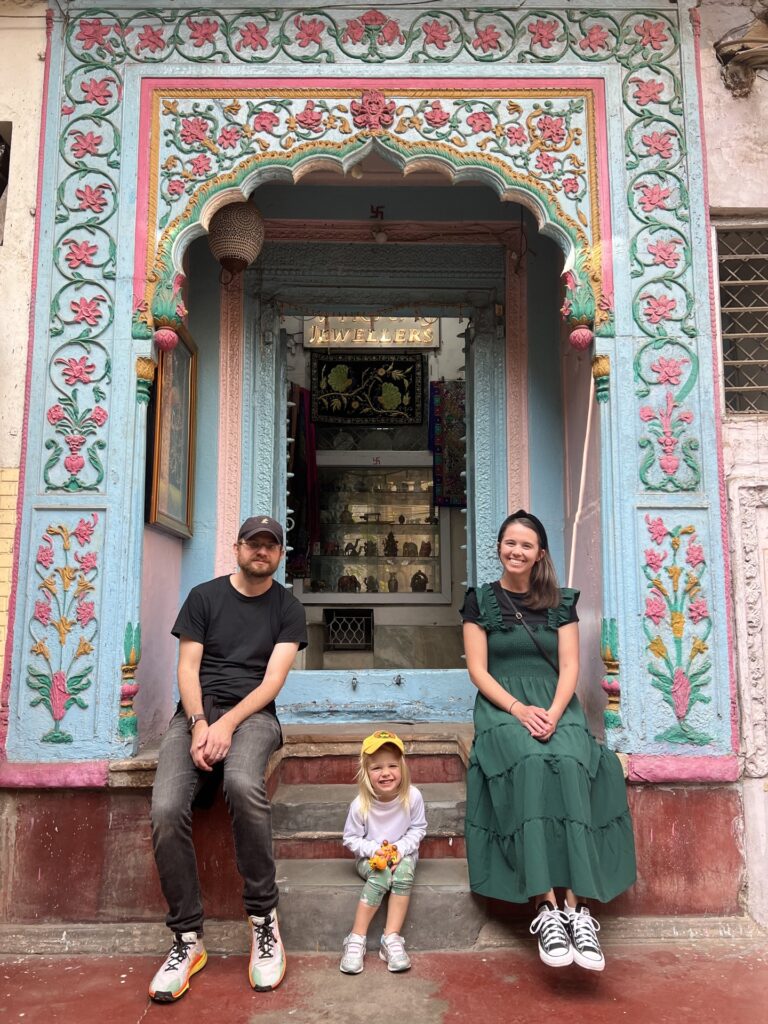
Other India Guides
We’ve written detailed guides about many individual components of our Golden Triangle travels. For more things to do in each city, detailed attraction notes, more tips and thorough reviews, check out some of these more focused posts.
- Flight to Delhi: Air India Business Class from Dubai to Delhi Review
- Hotel in Delhi: The Oberoi New Delhi Hotel Review
- Delhi City Guide: 3 Days in Delhi — Sample Itinerary + Planning Guide
- Car service from Delhi to Jaipur: We booked through Bagga India Tour (We did not write a full review on this.)
- Hotel in Jaipur: Review of Jai Mahal Palace
- Jaipur City Guide: Jaipur Itinerary — 1 or 2 Days in the Pink City
- Jaipur to Agra: We did not make this connection directly. We added a few days in Udaipur in the middle.
- Hotel in Agra + Taj Mahal Guide: The Oberoi Amarvilas Review
- Train from Agra to Delhi: Kerala Express Review — Agra to Delhi in AC 2-Tier Sleeper Class
- Airport Hotel in Delhi: JW Marriott New Delhi Aerocity Hotel Review
- Flight out of Delhi: Qatar Airways Economy from Delhi to Doha
And finally, if you’re considering going to India with kids, we have an entire guide dedicated to just that topic!
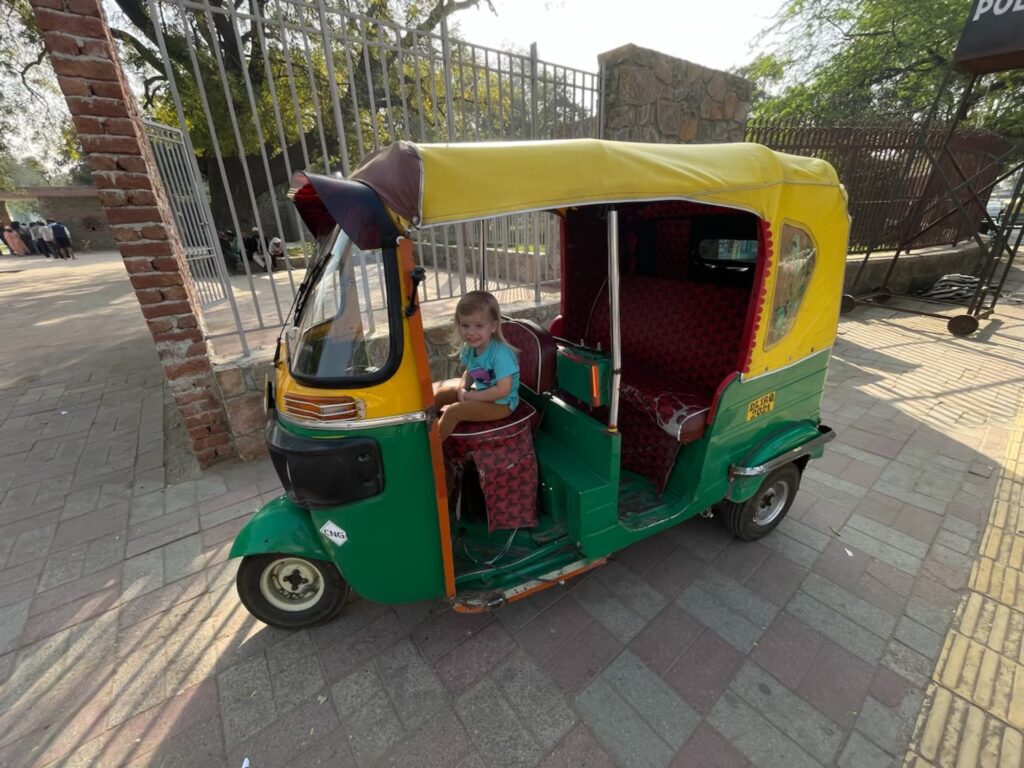
More From This Trip
- Emirates Business Class Review – A380 JFK to DXB
- Our Stay at Atlantis Dubai – A Perfect Place to Recharge
- Detailed 2-Day Dubai Itinerary
- Air India Business Class Review – 787 from DXB to DEL
- A Parent’s Guide to Traveling to India with Kids
- India Golden Triangle in 10 Days [Travel Guide, Itinerary &Tips]
- 3 Days in Delhi – Sample Itinerary + Planning Guide
- The Oberoi New Delhi Hotel Review
- Jaipur Itinerary – 1 or 2 Days in the Pink City
- Review of Jai Mahal Palace (Jaipur)
- Train from Jaipur to Udaipur – AC 3-Tier Sleeper Class
- The Oberoi Udaivilas Hotel Review (Udaipur)
- Udaipur Travel Guide + Things To Do
- Celebrating Holi in Udaipur (With a Kid)
- Overnight Train from Udaipur to Agra – AC First Class Sleeper
- The Oberoi Amarvilas Review: A Luxury Hotel with Taj Mahal Views
- Kerala Express Review – Agra to Delhi in AC 2-Tier Sleeper Class
- Hotel Review: JW Marriott New Delhi Aerocity
- Qatar Airways Economy Review – DEL to DOH
- Doha Things To Do & Travel Guide (Perfect for a Stopover!)
- Qatar Airways Qsuite Review – 777 from DOH to JFK

Barbara
Saturday 7th of December 2024
Great article, it will be very useful for our upcoming trip!!!